Plurality philosophy in an incredibly oversized nutshell
2024 Aug 21
See all posts
Plurality philosophy in an incredibly oversized nutshell
Special thanks to Glen Weyl and Audrey Tang for discussion and
Karl Floersch for review.
One of the interesting tensions in the crypto space, which has become
a sort of digital home for my
geographically nomadic self over the last decade, is its
relationship to the topic of governance. The crypto space hails
from the cypherpunk movement, which values independence from
external constraints often imposed by ruthless and power-hungry
politicians and corporations, and has for a long time built technologies
like torrent networks and encrypted messaging to achieve these ends.
With newer ideas like blockchains, cryptocurrencies and DAOs, however,
there is an important shift: these newer constructions are long-lived,
and constantly evolving, and so they have an inherent need to
build their own governance, and not just circumvent the governance of
unwanted outsiders. The ongoing survival of these structures
depends crucially on mathematical research, open source software, and
other large-scale public goods. This requires a shift in mentality: the
ideology that maintains the crypto space needs to transcend the ideology
that created it.
These kinds of complex interplays between coordination and freedom,
especially in the context of newer technologies, are everywhere in our
modern society, going far beyond blockchains and cryptocurrency. Earlier
this year, Florida governor Ron DeSantis signed a
bill that would ban synthetic (aka "lab-grown") meat from the state,
arguing that "global elites want to control our behavior and push a diet
of petri dish meat and bugs on Americans", and that we need to
"prioritize our farmers and ranchers over ... the World Economic Forum".
As you might expect, the Libertarian Party New Hampshire account
publicly criticized the "authoritarian
socialist" nature of the legislation. But as it turned out, many
other self-described libertarians did not share the same opinion:

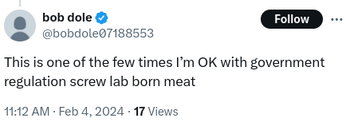
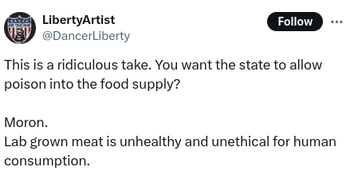

To me, LPNH's criticism of DeSantis's ban makes total sense: banning
people from eating a new and potentially far more ethical and
sustainable form of meat, on the basis of little more than a disgust
reflex, is the exact opposite of valuing freedom. And yet, it's clear
that many others do not feel the same way. When I scoured the internet
for cogent arguments why, the most compelling I could find is this argument
from Roko Mijic: in short, once something like this is allowed, it
becomes mainstream, society reorganizes around it, and the lives of
those who do not want to follow along inevitably become harder and
harder. It happened with digital cash, to the point where even the
Swedish central bank is worried about cash payments accessibility,
so why wouldn't it happen in other sectors of technology as well?
About two weeks after the DeSantis signed the bill banning lab-grown
meat, Google announced that it was rolling out
a feature into Android that would analyze the contents of calls in
real time, and would automatically give the user a warning if it thinks
the user might be getting scammed. Financial scams are a large and
growing problem, especially in regions like Southeast Asia, and they are
becoming increasingly sophisticated more rapidly than many people can
adapt. AI is accelerating
this trend. Here, we see Google, creating a solution to help warn
users about scams, and what's more, the solution is entirely
client-side: there's no personal data being shipped off to any
corporate or governmental Big Brother. This seems amazing; it's
exactly the kind of tech that I advocated for in my
post introducing "d/acc". However, not all freedom-minded people
were happy, and at least one of the detractors was very difficult to
dismiss as "just a Twitter troll": it was Meredith Whittaker, president
of the Signal Foundation.
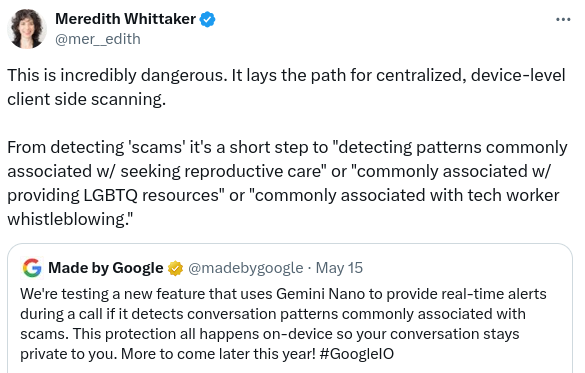
All three of these tensions are examples of things that have made a
deep philosophical question repeatedly pop into my mind: what is
the thing that people like myself, who think of ourselves as principled
defenders of freedom, should actually be defending? What is the
updated version of Scott Alexander's notion of liberalism
as a peace treaty that makes sense in the twenty first century?
Clearly, the facts have changed. Public goods are much more important
than before, at larger scales than before. The internet has made
communication abundant, rather than scarce. As Henry Farrell analyzed in
his
book on weaponized interdependence, modern information technology
doesn't just empower the recipient: it also enables ongoing power
projection by the creator. Existing attempts to deal with these
questions are often haphazard, trying to treat them as exceptions that
require principles to be tempered by pragmatic compromise. But what if
there was a principled way of looking at the world, which values freedom
and democracy, that can incorporate these challenges, and deal with them
as a norm rather than an exception?
Table of contents
Plurality, the book
The above is not how Glen Weyl and Audrey Tang introduce
their new book, Plurality: the
future of collaborative technology and democracy. The narrative that
animates Glen is a somewhat different one, focusing on the increasingly
antagonistic relationship between many Silicon Valley tech industry
figures and the political center-left, and seeking to find a more
collaborative way forward:
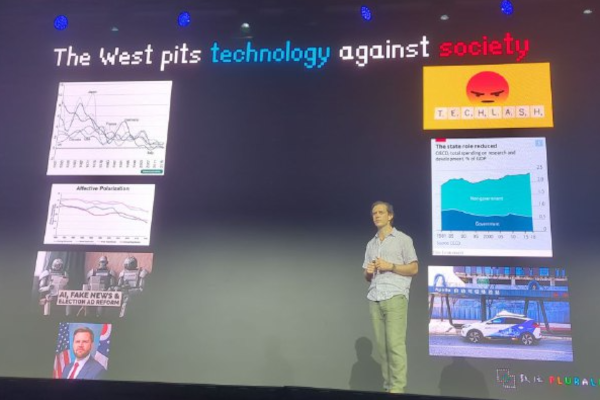
Glen Weyl, introducing the Plurality book in a presentation in
Taipei
But it felt more true to the spirit of the book for me to give an
introduction that gestures at a related set of problems from my own
angle. After all, it is an explicit goal of Plurality to try to be
compelling to a pretty wide group of people with a wide set of concerns,
that draw from all different parts of the traditional political
spectrum. I've long been concerned about what has felt to me like a
growing decline of support for not just democracy but even freedom,
which seems to have accelerated since around 2016.
I've also had a front-row seat dealing with questions of governance
from the governance builder's side, from my role within the Ethereum
ecosystem. At the start of my Ethereum journey, I was originally
animated by the dream of creating a governance mechanism that was
provably mathematically optimal, much like we have provably optimal consensus
algorithms. Five years later, my intellectual exploration ended up
with me figuring out the theoretical
arguments why such
a thing is mathematically
impossible.
Glen's intellectual evolution was in many ways different from mine,
but in many ways similar. His previous book Radical
Markets featured ideas inspired by classical liberal economics, as
well as more recent mathematical discoveries in the field, to try to
create better versions of property rights and democracy that solve the
largest problems with both mechanisms. Just like me, he has always found
ideas of freedom and ideas of democracy both compelling, and has tried
to find the ideal combination of both, that treats them not as opposite
goals to be balanced, but as opposite sides of the same coin that need
to be integrated. More recently, just like what happened with me, the
mathematical part of his social thinking has also moved in the direction
of trying to treat not just individuals, but also
connections between individuals, as a first-class object that
any new social design needs to take into account and build
around, rather than treating it as a bug that needs to be
squashed.
It is in the spirit of these ideas, as well as in the spirit of an
emerging transition from theory to practice, that the Plurality book is
written.
How would I define
Plurality in one sentence?
In his 2022 essay "Why
I Am A Pluralist", Glen Weyl defines pluralism most succinctly as
follows:
I understand pluralism to be a social philosophy that recognizes and
fosters the flourishing of and cooperation between a diversity of
sociocultural groups/systems.
If I had to expand on that a little bit, and define Plurality the
book in four bullet points, I would say the following:
- Glen's megapolitics: the idea that the world today
is stuck in a narrow
corridor between conflict and centralization, and we need a new and
upgraded form of highly performant digital democracy as an alternative
to both.
- Plurality the vibe: the general theme that (i) we
should understand the world through a patchwork combination of models,
and not try to stretch any single model to beyond its natural
applicability, and (ii) we should take connections between
individuals really seriously, and work to expand and strengthen
healthy connections.
- Plurality-inspired mechanism design: there is a set
of principled mathematical techniques by which you can design social,
political and economic mechanisms that treat not just
individuals, but also connections between individuals
as a first-class object. Doing this can create newer forms of markets
and democracy that solve common problems in markets and democracy today,
particularly around bridging tribal divides and polarization.
- Audrey's practical experience in Taiwan: Audrey has
already incorporated a lot of Plurality-aligned ideas while serving as
Digital Minister in Taiwan, and this is a starting point that can be
learned from and built upon.
The book also includes contributions from many authors other than
Glen and Audrey, and if you reach the chapters closely you will notice
the different emphases. However, you will also find many common
threads.
What are the
megapolitics of Plurality?
In Balaji Srinivasan's magnum opus The
Network State, Balaji described his vision of the current world as
being split between three poles: center-left Anglosphere elites
exemplified by the New York Times (NYT), the Chinese Communist Party
(CCP), and ultra-individualistic right-leaning people as exemplified by
Bitcoin (BTC). Glen, both in the Plurality book and elsewhere,
has given his own characterization of the "political ideologies of the
21st century", that looks as follows:
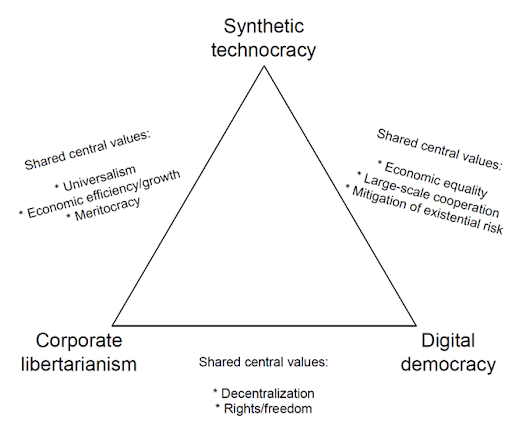
The names of the three are taken from Civilization 6,
and in the Plurality book Glen simplifies the names to
Technocracy, Libertarianism and
Plurality. He describes the three roughly as
follows:
- (Synthetic) Technocracy: some mechanism run by a
combination of AI and a small human elite creates lots of amazing stuff,
and makes sure that everyone gets the share they need to live a good
life (eg. via UBI). Political input from non-elites is considered
unimportant. Examples of this ideology include the Chinese Community
Party, the World Economic Forum ("you will own nothing and you will be
happy"), Sam
Altman and friends' UBI advocacy, and from my recent travels, I
would perhaps add the Dubai
Museum of the Future.
- (Corporate) Libertarianism: maximize security of
property rights and freedom of contract, and expect that most important
projects are started by some kind of "great founder" entrepreneur.
Individuals are protected from abuse almost entirely through the right
to "exit" any system that becomes too inefficient or exploitative.
Examples of this ideology include books like The
Sovereign Individual, free city movements like Prospera,
as well as network states.
- Digital democracy / Plurality: use internet-enabled
technology to create much more high-bandwidth democratic mechanisms that
can aggregate preferences from a very wide group of people, and use
these mechanisms to create a much more powerful and effective
"third-sector" or "civil society" that can make much better decisions.
Examples that Glen cites include both fiction, most notably Star Trek
and anything by Ursula le
Guin, and real-life proto-examples, most notably e-government in
Estonia and Taiwan.
Glen sees Plurality as being uniquely able to simultaneously avoid
three failure modes: coordination failure leading to
conflict (which he sees Libertarianism as risking),
centralization and authoritarianism (which he sees
Technocracy as risking), and stagnation (which he sees
"old-world democracy" as risking, causing it to lose competitiveness
against Libertarianism and Technocracy). Glen sees Plurality as an
under-explored alternative which it is his project to flesh out as an
idea, and Audrey's project to bring to life, first in Taiwan then
elsewhere.
If I had to summarize the difference between Balaji's program and
Glen and Audrey's program, I would do so as follows. Balaji's vision
centers around creating new alternative institutions and new communities
around those new institutions, and creating safe spaces to give them a
chance to grow. Glen and Audrey's approach, on the other hand, is best
exemplified by her "fork-and-merge"
strategy in e-government in Taiwan:
So, you visit a regular government website, you change your O to a
zero, and this domain hack ensures that you're looking at a shadow
government versions of the same website, except it's on GitHub, except
it's powered by open data, except there's real interactions going on and
you can actually have a conversation about any budget item around this
visualization with your fellow civic hackers.
And many of those projects in Gov Zero became so popular that the
administration, the ministries finally merged back their code so that if
you go to the official government website, it looks exactly the same as
the civic hacker version.
There is still some choice and exit in Audrey's vision, but
there is a much tighter feedback loop by which the improvements created
by micro-exits get merged back into "mainline" societal
infrastructure. Balaji would ask: how do we let the synthetic
meat people have their synthetic meat city, and the traditional meat
people have their traditional city? Glen and Audrey might rather ask:
how do we structure the top levels of society to guarantee people's
freedom to do either one, while still retaining the benefits of being
part of the same society and cooperating on every other axis?
What is the
Plurality model of "the world as it is"?
The Plurality view on how to improve the world starts with a
view on how to describe the world as it is. This is a key part
of Glen's evolution, as the Glen of ten years ago had a much more
economics-inspired perspective toward these issues. For this reason,
it's instructive to compare and contrast the Plurality worldview with
that of traditional economics.
Traditional economics focuses heavily on a small number of economic
models that make particular assumptions about how agents operate, and
treats deviations from these models as bugs whose consequences are not
too serious in practice. As given in textbooks, these assumptions
include:
- Competition: the common
case for the efficiency of markets relies on the assumption that no
single market participant is large enough to significantly move market
prices with their actions - instead, the prices they set only determine
whether or not anyone buys their product.
- Perfect information: people in a market are fully
informed about what products they are purchasing
- Perfect rationality: people in a market have
consistent goals and are acting toward achieving those goals (it's
allowed for these goals to be altruistic)
- No externalities: production and use of the things
being traded in a marketplace only affects the producer and user, and
not third parties that you have no connection with
In my own recent writing, I generally put a stronger emphasis on an
assumption that is related to competition, but is much stronger:
independent choice. Lots of mechanisms proposed by
economists work perfectly if you assume that people are acting
independently to pursue their own independent objectives, but break down
quickly once participants are coordinating their actions though some
mechanism outside of the rules that you set up. Second price auctions
are a great example: they are provably perfectly efficient if the above
conditions are met and the participants are independent, but break
heavily if the top bidders can collude. Quadratic
funding, invented by myself, Glen Weyl and Zoe Hitzig, is similar:
it's a provably ideal mechanism for funding public goods if participants
are independent, but if even two participants collude, they can extract
an unbounded amount of money from the mechanism. My own work in pairwise-bounded
quadratic funding tries to plug this hole.
But the usefulness of economics breaks down further once you start to
analyze incredibly important parts of society that don't look like like
trading platforms. Take, for instance, conversations. What are the
motivations of speakers and listeners in a conversation? As Hanson and
Simler point out in The Elephant In The
Brain, if we try to model conversations as information
exchange, then we would expect to see people guarding information
closely and trying to play tit-for-tat games, saying things only in
exchange for other people saying things in return. In reality, however,
people are generally eager to share information, and criticism of
people's conversational behavior often focuses on many people's tendency
to speak too much and listen too little. In public
conversations such as social media, a major topic of analysis is what
kinds of statements, claims or memes go viral - a term that
directly admits that the most natural scientific field to draw analogies
from is not economics, but biology.
So what is Glen and Audrey's alternative? A big part of it is
simply recognizing that there is simply no single model or scientific
approach that can explain the world perfectly, and we should
use a combination of different models instead, recognizing the limits of
the applicability of each one. In a key
section, they write:
Nineteenth century mathematics saw the rise of formalism: being
precise and rigorous about the definitions and properties of
mathematical structures that we are using, so as to avoid
inconsistencies and mistakes. At the beginning of the 20th century,
there was a hope that mathematics could be "solved", perhaps even giving
a precise algorithm for determining the truth or falsity of any
mathematical claim.[6] 20th century mathematics, on the other hand, was
characterized by an explosion of complexity and uncertainty.
- Gödel's Theorem: A number of mathematical results
from the early 20th century, most notably Gödel's theorem, showed that
there are fundamental and irreducible ways in which key parts of
mathematics cannot be fully solved.
- Computational complexity: Even when reductionism is
feasible in principle/theory, the computation required to predict
higher-level phenomena based on their components (its computational
complexity) is so large that performing it is unlikely to be practically
relevant.
- Sensitivity, chaos, and irreducible uncertainty:
Many even relatively simple systems have been shown to exhibit "chaotic"
behavior. A system is chaotic if a tiny change in the initial conditions
translates into radical shifts in its eventual behavior after an
extended time has elapsed
- Fractals: Many mathematical structures have been
shown to have similar patterns at very different scales. A good example
of this is the Mandelbrot set.
Glen and Audrey proceed to give similar examples from physics. An
example that I (as one of many co-contributors in the wiki-like process
of producing the book) contributed, and they accepted, was:
- The three body problem, now famous after its
central role in Liu Cixin's science-fiction series, shows that an
interaction of even three bodies, even under simple Newtonian physics,
is chaotic enough that its future behavior cannot be predicted with
simple mathematical problems. However, we still regularly solve
trillion-body problems well enough for everyday use by using
seventeenth-century abstractions such as "temperature" and
"pressure".
In biology, a key example is:
- Similarities between organisms and ecosystems: We
have discovered that many diverse organisms ("ecosystems") can exhibit
features similar to multicellular life (homeostasis, fragility to
destruction or over propagation of internal components, etc.)
illustrating emergence and multiscale organization.
The theme of these examples should at this point be easy to see.
There is no single model that can be globally applicable, and the best
that we can do is stitch together many kinds of models that work well in
many kinds of situations. The underlying mechanisms at different scales
are not the same, but they do "rhyme". Social science, they argue, needs
to go in the same direction. And this is exactly where, they argue,
"Technocracy" and "Libertarianism" fail:
In the Technocratic vision we discussed in the previous chapter, the
"messiness" of existing administrative systems is to be replaced by a
massive-scale, unified, rational, scientific, artificially intelligent
planning system. Transcending locality and social diversity, this
unified agent is imagined to give "unbiased" answers to any economic and
social problem, transcending social cleavages and differences. As such,
it seeks to at best paper over and at worst erase, rather than fostering
and harnessing, the social diversity and heterogeneity that ⿻ social
science sees as defining the very objects of interest, engagement, and
value.
In the Libertarian vision, the sovereignty of the atomistic
individual (or in some versions, a homogeneous and tightly aligned group
of individuals) is the central aspiration. Social relations are best
understood in terms of "customers", "exit" and other capitalist
dynamics. Democracy and other means of coping with diversity are viewed
as failure modes for systems that do not achieve sufficient alignment
and freedom.
One particular model that Glen and Audrey come back to again and
again is Georg
Simmel's theory of individuality as arising from each individual
being at a unique intersection of different groups. They describe this
as being a long-lost third alternative to both "atomistic individualism"
and collectivism. They write:
In [Georg Simmel's] view, humans are deeply social creatures and thus
their identities are deeply formed through their social relations.
Humans gain crucial aspects of their sense of self, their goals, and
their meaning through participation in social, linguistic, and
solidaristic groups. In simple societies (e.g., isolated, rural, or
tribal), people spend most of their life interacting with the kin groups
we described above. This circle comes to (primarily) define their
identity collectively, which is why most scholars of simple societies
(for example, anthropologist Marshall Sahlins) tend to favor
methodological collectivism.[14] However, as we noted above, as
societies urbanize social relationships diversify. People work with one
circle, worship with another, support political causes with a third,
recreate with a fourth, cheer for a sports team with a fifth, identify
as discriminated against along with a sixth, and so on.
As this occurs, people come to have, on average, less of their full
sense of self in common with those around them at any time; they begin
to feel "unique" (to put a positive spin on it) and
"isolated/misunderstood" (to put a negative spin on it). This creates a
sense of what he called "qualitaitive individuality" that helps explain
why social scientists focused on complex urban settings (such as
economists) tend to favor methodological individualism. However,
ironically as Simmel points out, such "individuation" occurs precisely
because and to the extent that the "individual" becomes divided among
many loyalties and thus dividual.
This is the core idea that the Plurality book comes back to again and
again: treating connections between individuals as a first
class object in mechanism design, rather than only looking at
individuals themselves.
How does
Plurality differ from libertarianism?
Robert Nozick, in his 1974 book Anarchy,
State and Utopia, argued for a minimal government that performs
basic functions like preventing people from initiating violent force,
but otherwise leaves it up to people to self-organize into communities
that fulfill their values. This book has become something of a manifesto
describing an ideal world for many classical liberals since then.
Two examples that come to mind for me are Robin Hanson's recent post
Libertarianism
as Deep Multiculturalism, and Scott Alexander's 2014 post Archipelago
and Atomic Communitarianism. Robin is interested in this concept
because he wants to see a world that has more of what he calls deep
multiculturalism:
A shallow "multiculturalism" tolerates and even celebrates diverse
cultural markers, such as clothes, food, music, myths, art, furniture,
accents, holidays, and dieties. But it is usually also far less tolerant
of diverse cultural values, such as re war, sex, race, fertility,
marriage, work, children, nature, death, medicine, school, etc. It seeks
a "mutual understanding" that that we are (or should be) all really the
same once we get past our different markers.
In contrast, a deep "multiculturalism" accepts and even celebrates
the co-existence of many cultures with diverse deeply-divergent values.
It seeks ways for a world, and even geographic regions, to encompass
such divergent cultures under substantial peace and prosperity. It
expects some mistrust, conflict, and even hostility between cultures,
due to their divergent values. But it sees this as the price to pay for
deep cultural variety.
As most non-libertarian government activities are mainly justified as
creating and maintaining shared communities/cultures and their values,
this urge to use government to promote shared culture seems the main
obstacle to libertarian-style governance. That is, libertarians hope to
share a government without sharing a community or culture. The usual
"libertarian" vs "statist" political axis might be seen as an axis re
how much we want to share culture, versus allow divergent cultures
Scott Alexander comes to similar conclusions in his 2014 post, though
his underlying goal is slightly different: he wants to find an ideal
political architecture that creates the opportunity for organizations to
support public goods and limit public bads that are culturally
subjective, while limiting the all-too-common tendency for subjective
arguments about higher-order harm ("the gays are corroding the social
fabric") to become a mask for oppression. Balaji's The Network
State is a much more concrete proposal for a social architecture
that tries to accomplish exactly the same objective.
And so a key question worth asking is: where exactly is
libertarianism insufficient to bring about a Plural society? If
I had to summarize the answer in two sentences, I would say:
- Plurality is not just about enabling pluralism,
it's also about harnessing it, and about making a much
more aggressive effort to build higher-level institutions that maximize
positive-sum interactions between different groups and minimize
conflict.
- Plurality is not just at the level of society, it's also
within each individual, allowing each individual to be
part of multiple tribes at the same time.
To understand (2), we can zoom in on one particular example. Let us
look at the debate around Google's on-device anti-fraud scanning system
in the opening section. On one side, we have a tech company releasing a
product that seems to be earnestly motivated by a desire to protect
users from financial scams (which are a very real problem and have cost
people I personally know hundreds of thousands of dollars), which even
goes the extra mile and checks the most important "cypherpunk values"
boxes: the data and computation stays entirely on-device and it's purely
there to warn you, not report you to law enforcement. On the other side,
we see Meredith Whittaker, who sees the offering as a slippery slope
toward something that does do more oppressive things.
Now, let's look at Glen's preferred alternative: a Taiwanese app
called Message Checker.
Message checker is an app that runs on your phone, and intercepts
incoming message notifications and does analysis with them. This
includes features that have nothing to do with scams, such as using
client-side algorithms to identify messages that are most important for
you to look at. But it also detects scams:

A key part of the design is that the app does not force all of its
users into one global set of rules. Instead, it gives users a choice of
which filters they turn on or off:

From top to bottom: URL checking, cryptocurrency address
checking, rumor checking.
These are all filters that are made by the same company. A more ideal
setup would have this be part of the operating system, with an open
marketplace of different filters that you can install, that would be
created by a variety of different commercial and non-profit actors.
The key Pluralist feature of this design is: it gives users
more granular freedom of exit, and avoids being all-or-nothing.
If a norm that on-device anti-fraud scanning must work in this
way can be established, then it seems like it would make Meredith's
dystopia much less likely: if the operator decides to add a filter that
treats information about transgender care (or, if your fears go the
other direction, speech advocating limits on gender self-categorization
in athletics competitions) as dangerous content, then individuals would
be able to simply not install that particular filter, and they would
still benefit from the rest of the anti-scam protection.
One important implication is that "meta-institutions" need to be
designed to encourage other institutions to respect this ideal of
granular freedom of exit - after all, as we've seen with software vendor lock-in,
organizations don't obey this principle automatically!
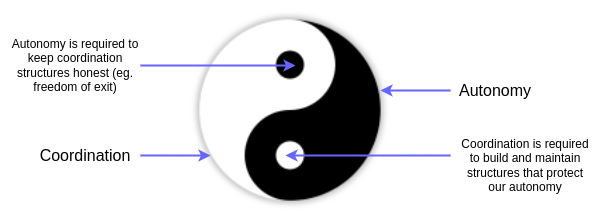
One way to think about the complex interplay between coordination
and autonomy in Plurality.
How does Plurality
differ from democracy?
A lot of the differences between Plural democracy and traditional
democracy become clear once you read the chapter
on voting. Plural voting mechanisms have some strong explicit
answers to the "democracy is two wolves and one sheep voting on what's
for dinner" problem, and related worries about democracy descending into
populism. These solutions build on Glen's
earlier ideas around quadratic voting, but go a step further, by
explicitly counting votes more highly if those votes come from actors
that are more independent of each other. I will get into this more in a
later section.
In addition to this big theoretical leap from only counting
individuals to also counting connections, there are also broad thematic
differences. One key difference is Plurality's relationship to nation
states. A major disadvantage of nation-state democracy that speaks to me
personally was summarized well in this tweet by libertarian philosopher
Chris Freiman:

This is a serious gap: two thirds of global inequality is
between countries rather than within countries, an increasing number
of (especially digital) public goods are not global but also not clearly
tied to any specific nation state, and the tools that we use for
communication are highly international. A 21st century program for
democracy should take these basic facts much more seriously.
Plurality is not inherently against the existence of nation states,
but it makes an explicit effort to expand beyond relying on nation
states as its locus of action. It has prescriptions for how all kinds of
actors can act, including transnational organizations, social media
platforms, other types of businesses, artists and more. It also
explicitly acknowledges that for many people, there is no overarching
single nation-state that dominates their lives.
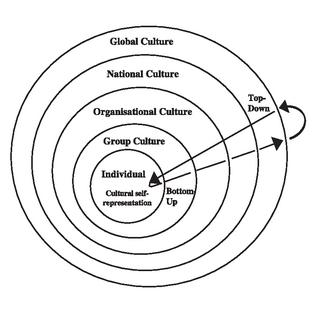
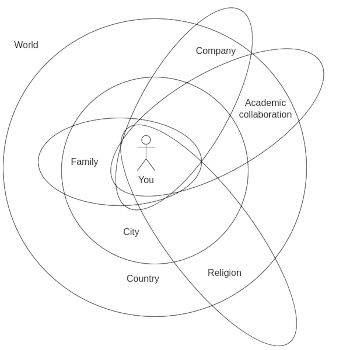
Left: a concentric circle view of society, from a
sociology paper in 2004. Right: a Plural view of society:
intersecting, but non-hierarchical circles.
A big theme of Plurality is expanded on in much more detail in Ken
Suzuki's Smooth
Society and its Enemies: the idea that membership in an organization
should not be treated as a "true-or-false" question. Instead, there
should be different degrees of membership, and these different degrees
would carry different benefits and different levels of obligation. This
is an aspect of society that was always true, but becomes much more
important in an internet-first world where our communities are no longer
necessarily nested and fully overlapping.
What
are some specific technologies that the Plurality vision advocates?
The Plurality book advocates for a pretty wide set of digital and
social technologies that stretch across what are traditionally
considered a large number of "spaces" or industries. I will give
examples by focusing on a few specific categories.
Identity
First, Glen and Audrey's criticism of existing approaches to
identity. Some key quotes from the chapter
on this topic:
Many of the simplest ways to establish identity paradoxically
simultaneously undermine it, especially online. A password is often used
to establish an identity, but unless such authentication is conducted
with great care it can reveal the password more broadly, making it
useless for authentication in the future as attackers will be able to
impersonate them. "Privacy" is often dismissed as "nice to have" and
especially useful for those who "have something to hide". But in
identity systems, the protection of private information is the very core
of utility. Any useful identity system has to be judged on its ability
to simultaneously establish and protect identities.
On biometrics:
[Biometrics] have important limits on their ability to establish and
protect identities. Linking such a wide variety of interactions to a
single identifier associated with a set of biometrics from a single
individual collected at enrollment (or registration) forces a stark
trade-off. On the one hand, if (as in Aadhaar) the administrators of the
program are constantly using biometrics for authentication, they become
able to link or see activities to these done by the person who the
identifier points to, gaining an unprecedented capacity to surveil
citizen activities across a wide range of domains and, potentially, to
undermine or target the identities of vulnerable populations.
On the other hand, if privacy is protected, as in Worldcoin, by using
biometrics only to initialize an account, the system becomes vulnerable
to stealing or selling of accounts, a problem that has decimated the
operation of related services ... If eyeballs can, sometime in the future,
be spoofed by artificial intelligence systems combined with advanced
printing technology, such a system may be subject to an extreme "single
point of failure".
Glen and Audrey's preferred approach is intersectional social
identity: using the entire set of a person's actions and
interactions to serve the underlying goals of identity systems, like
determining the degree of membership in communities and degree of
trustworthiness of a person:
This social, Plural approach to online identity was pioneered by
danah boyd in her astonishingly farsighted master's thesis on "faceted
identity" more than 20 years ago.[28] While she focused primarily on the
benefits of such a system for feelings of personal agency (in the spirit
of Simmel), the potential benefits for the balance between identity
establishment and protection are even more astonishing:
- Comprehensiveness and redundancy: For almost
anything we might want to prove to a stranger, there is some combination
of people and institutions (typically many) who can "vouch" for this
information without any dedicated strategy of surveillance. For example,
a person wanting to prove that they are above a particular age could
call on friends who have known them for a long time, the school they
attended, doctors who verified their age at various times as well, of
course, on governments who verified their age.
- Privacy: Perhaps even more interestingly, all of
these "issuers" of attributes know this information from interactions
that most of us feel consistent with "privacy": we do not get concerned
about the co-knowledge of these social facts in the way we would
surveillance by a corporation or government.
- Security: Plurality also avoids many of the
problems of a "single point of failure". The corruption of even several
individuals and institutions only affects those who rely on them, which
may be a very small part of society, and even for them, the redundancy
described above implies they may only suffer a partial reduction in the
verification they can achieve.
- Recovery: individuals [could] rely on a group of
relationships allowing, for example, 3 of 5 friends or institutions to
recover their key. Such "social recovery" has become the gold standard
in many Web3 communities and is increasingly being adopted even by major
platforms such as Apple.
The core message is any single-factor technique is too
fragile, and so we should use multi-factor techniques. For
account recovery, it is relatively
easy to see how this works, and it's easy to understand the security
model: each user chooses what they trust, and if a particular user makes
a wrong choice, the consequences are largely confined to that user.
Other use cases of identity, however, are more challenging. UBI and
voting, for example, seem like they inherently require global
(or at least community-wide) agreement on who the members of a
community are. But there are efforts that try very hard to bridge this
gap, and create something that comes close to "feeling" like a single
global thing, while being based on subjective multi-factorial trust
under the hood.
The best example in the Ethereum ecosystem would be Circles, a UBI coin project that is
based on a "web of trust", where anyone can create an account (or an
unlimited number of accounts) that generates 1 CRC per hour, but you
only treat a given account's coins as being "real Circles" if that
account is connected to you through a web-of-trust graph.
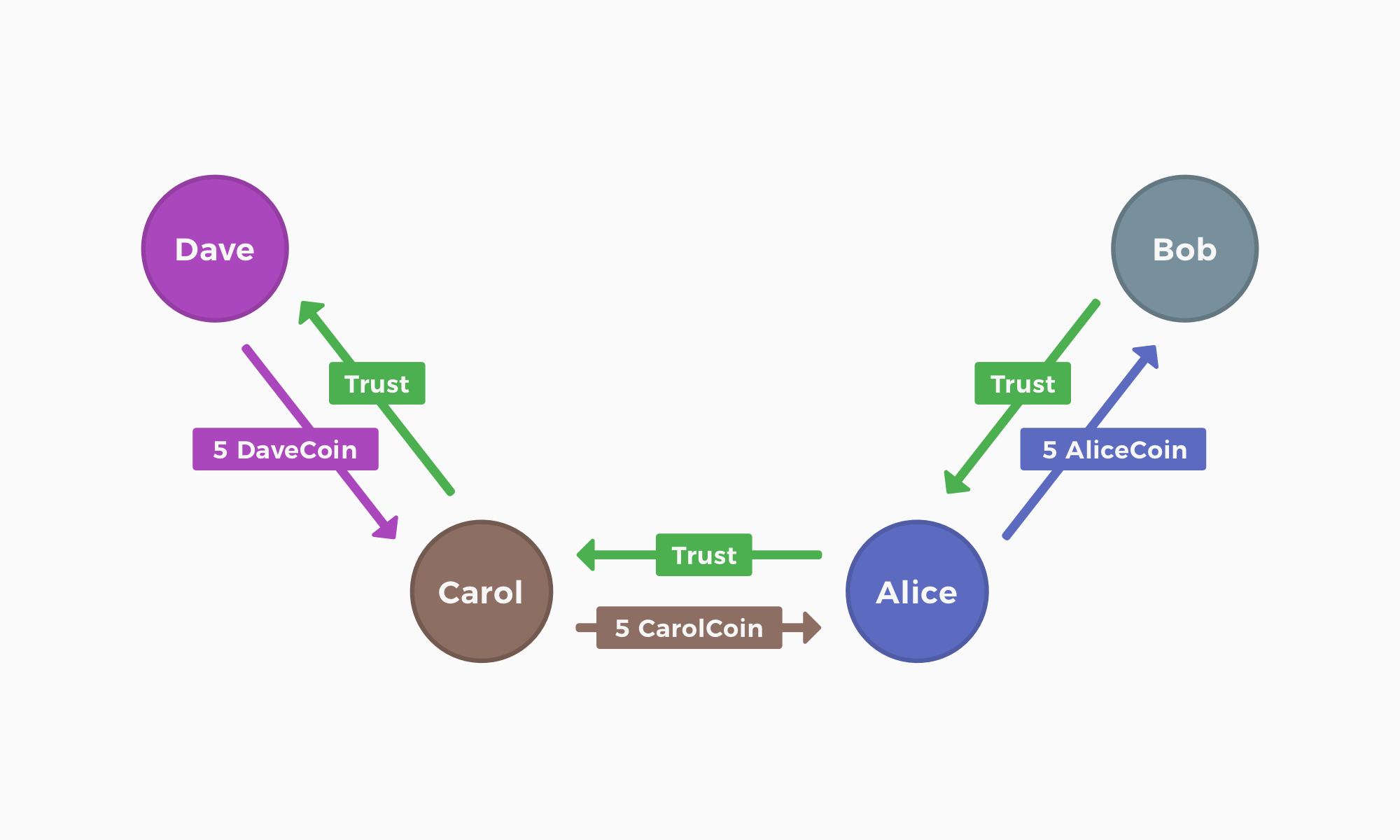
Propagation of trust in Circles, from the Circles
whitepaper
Another approach would be to abandon the "you're either a person or
you're not" abstraction entirely, and try to use a combination of
factors to determine the degree of trustworthiness and membership of a
given account, and give it a UBI or voting power proportional to that
score. Many airdrops that are being done in the Ethereum ecosystem, such
as the Starknet
airdrop, follow these kinds of principles.
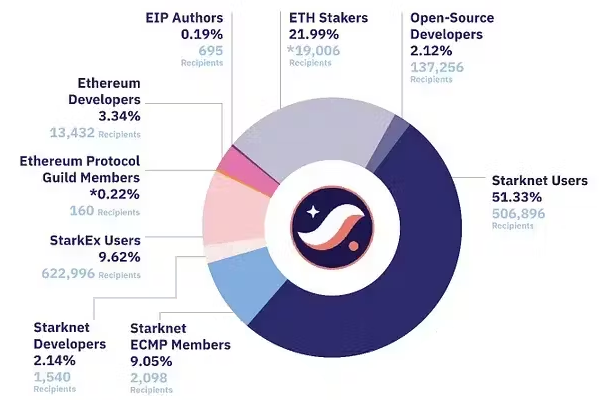
Starknet airdrop recipient categories. Many recipients ended up
falling into multiple categories.
Plural Money and Property
In Radical Markets, Glen focused a lot on the virtues "stable and
predictable, but deliberately imperfect" versions of property rights,
like Harberger
taxes. He also focused a lot on "market-like" structures that can
fund public goods and not just private goods, most notably quadratic
voting and quadratic funding. These are both ideas that continue to
be prominent in Plurality. A non-monetary implementation of quadratic
funding called Plural
Credits was used to help record contributions to the book itself.
The ideas around Harberger taxes are somewhat updated, seeking to extend
the idea into mechanisms that allow assets to be partially owned by
multiple different individuals or groups at the same time.
In addition to this ongoing emphasis on very-large-scale market
designs, one new addition to the program is a greater emphasis on
community currencies:
In a polycentric structure, instead of a single universal
currency, a variety of communities would have their own currencies which
could be used in a limited domain. Examples would be vouchers
for housing or schooling, scrip for rides at a fair, or credit at a
university for buying food at various vendors.[18] These currencies
might partially interoperate. For example, two universities in the same
town might allow exchanges between their meal programs. But it would be
against the rules or perhaps even technically impossible for a holder to
sell the community currency for broader currency without community
consent.
The underlying goal is to have a combination of local mechanisms that
are deliberately kept local, and global mechanisms to enable
very-large-scale cooperation. Glen and Audrey see their modified
versions of markets and property as being the best candidates for
very-large-scale global cooperation:
Those pursuing Plurality should not wish markets away. Something must
coordinate at least coexistence if not collaboration across the broadest
social distances and many other ways to achieve this, even ones as thin
as voting, carry much greater risks of homogenization precisely because
they involve deeper ties. Socially aware global markets offer much
greater prospect for Plurality than a global government. Markets must
evolve and thrive, along with so many other modes of collaboration, to
secure a Plural future.
Voting
In Radical Markets, Glen advocated quadratic voting, which deals with
the problem of allowing voters to express different strength of
preferences but while avoiding failure modes where the most extreme
or well-resourced voice dominates decision-making. In Plurality, the
core problem that Glen and Audrey are trying to solve is different, and
this
section does a good job of summarizing what new problem they are
trying to solve:
it is natural, but misleading, to give a party with twice the
legitimate stake in a decision twice the votes. The reason is that this
will typically give them more than twice as much power. Uncoordinated
voters on average cancel one another out and thus the total influence of
10,000 completely independent voters is much smaller than the influence
of one person with 10,000 votes.
When background signals are completely uncorrelated and there are
many of them, there is a simple way to mathematically account for this:
a series of uncorrelated signals grows as the square root of their
number, while a correlated signal grows in linear proportion to its
strength. Thus 10,000 uncorrelated votes will weigh as heavily as only
100 correlated ones.
To fix this, Glen and Audrey argue for designing voting mechanisms
with a principle of "degressive proportionality": treat uncorrelated
signals additively, but give N correlated signals only sqrt(N)
votes.
A precedent for this kind of approach exists in countries like the
United States and in international bodies, where there are typically
some chambers of governance that give sub-units (states in the former
case, countries in the latter case) a quantity of voting power
proportional to their population or economic power, and other chambers
of governance that give one unit of voting power to each sub-unit
regardless of size. The theory is that ten million voters from a big
state matter more than a million voters from a small state, but they
represent a more correlated signal than ten million voters from ten
different states, and so the voting power that the ten million voters
from a big state should be somewhere in between those two extremes.
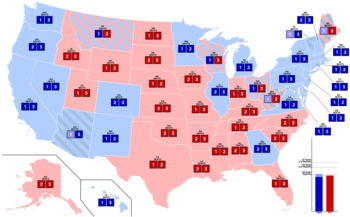
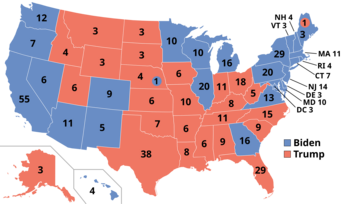
Left: US senate, two senators per state regardless of size.
Right: US electoral college, senator count roughly proportional to
population.
The key challenge to making this kind of design work in a more
general way is, of course, in determining who is "uncorrelated".
Coordinated actors pretending to be uncoordinated to increase their
legitimacy (aka "astroturfing", "decentralization larping", "puppet
states"...) is already a mainstream political tactic and has been for
centuries. If we instantiate a mechanism that determines who is
correlated to whom by analyzing Twitter posts, people will start
crafting their Twitter content to appear as uncorrelated as possible
toward the algorithm, and perhaps even intentionally create and use bots
to do this.
Here, I can plug my own proposed solution to this problem: vote
simultaneously on multiple issues, and use the votes themselves as a
signal of who is correlated to whom. One implementation of this was in
pairwise
quadratic funding, which allocates to each pair of
participants a fixed budget, which is then split based on the
intersection of how that pair votes. You can do a similar thing for
voting: instead of giving one vote to each voter, you can give one
(splittable) vote to each pair of voters:
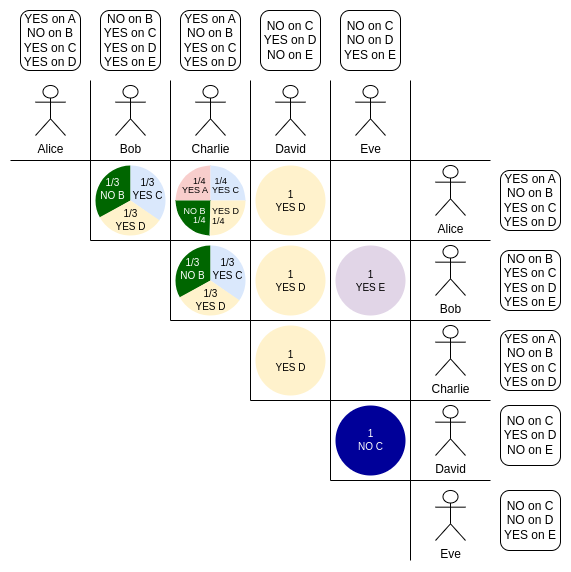
If you count by raw numbers, YES wins 3-2 on issue C. But Alice,
Bob and Charlie are highly correlated voters: they agree on almost
everything. Meanwhile, David and Eve agree on nothing but C. In pairwise
voting, the whole "NO on C" vote of the (David, Eve) pair would be
allocated to C, and it would be enough to overpower the "YES on C" votes
of Alice, Bob and Charlie, whose pairwise votes for C add up to only
11/12.
The key trick in this kind of design is that the determination of who
is "correlated" and "uncorrelated" is intrinsic to the mechanism. The
more that two participants agree on one issue, the less their vote
counts on all other issues. A set of 100 "organic" diverse participants
would get a pretty high weight on their votes, because the overlap area
of any two participants is relatively small. Meanwhile, a set of 100
people who all have similar beliefs and listen to the same media would
get a lower weight, because their overlap area is higher. And a set of
100 accounts that are all being controlled by the same owner would have
perfect overlap, because that's the strategy that maximizes the owner's
objectives, but they would get the lowest weight of all.
This "pairwise" approach is not the mathematically ideal way to
implement this kind of thing: in the case of quadratic funding, the
amount of money that an attacker can extract grows with the
square of the number of accounts they control, whereas ideally
it would be linear. There is an open research problem in
specifying an "ideal" mechanism, whether for quadratic funding or
voting, that has the strongest properties when faced with attackers
controlling multiple accounts or correlated voters.
This is a new type of democracy that naturally corrects for the
phenomenon that internet discourse sometimes labels as "NPCs": a large mass
of people that might as well just be one person because they're all
consuming exactly the same sources of information and believe all of the
same things.
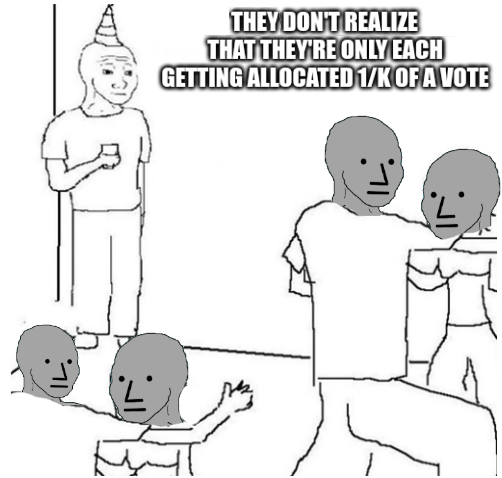
Conversations
As I've said on many occasions especially in the context of DAOs, the
success or failure of governance depends ~20% on the formal governance
mechanism, and ~80% on the structure of communication that the
participants engage in before they get to the step where they've settled
on their opinions and are inputting them into the governance. To that
end, Glen and Audrey have also spent quite a lot of time thinking about
better technologies for large-scale conversations.
One conversation tool that they focus on a lot is Polis. Polis is a system that allows
people to submit statements about an issue, and vote on each other's
statements. At the end of a round, it identifies the different major
"clusters" in the different points of view, and surfaces the statements
that were the most effective at getting support from all clusters.
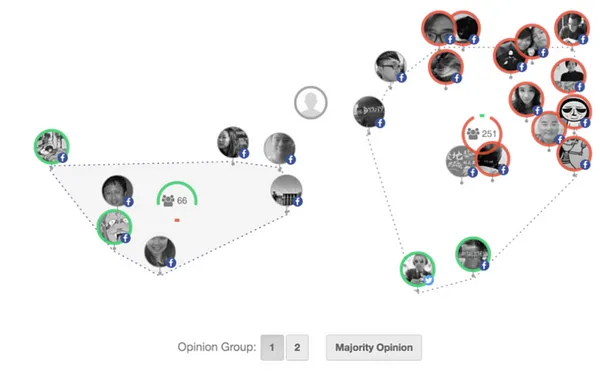
Source: https://words.democracy.earth/hacking-ideology-pol-is-and-vtaiwan-570d36442ee5
Polis was actually used in Taiwan during some public deliberations
over proposed laws, including agreeing on the rules for Uber-like ride
hailing services. It has been used in several other contexts around the
world as well, including some experiments within the Ethereum
community.
The second tool that they focus on is one that has had much more
success becoming mainstream, though in large part due to its "unfair
advantage" from being introduced into a pre-existing social media
platform with hundreds of millions of users: Twitter's Community
Notes.
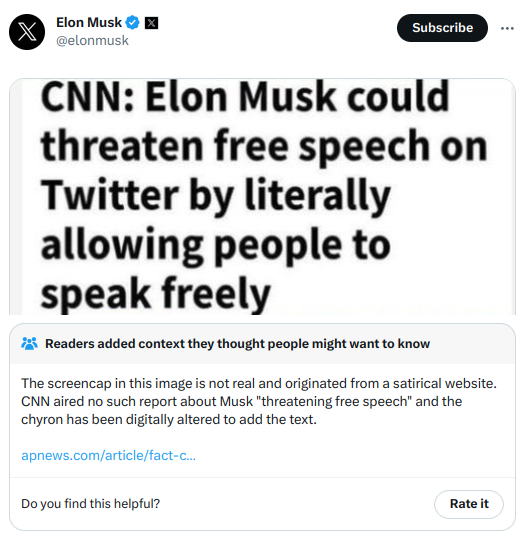
Community Notes similarly uses an algorithm that allows anyone to
submit a proposed note for a post, and shows the notes that are rated
the most highly by people who disagree on most other notes. I described
this algorithm in much more detail in my
review of the platform. Since then, Youtube has
announced that they are planning to introduce a similar feature.
Glen and Audrey want to see the underlying ideas behind these
mechanisms expanded on, and used much more broadly throughout the
platforms:
While [Community Notes] currently lines up all opinions across the
platform on a single spectrum, one can imagine mapping out a range of
communities within the platform and harnessing its bridging-based
approach not just to prioritize notes, but to prioritize content for
attention in the first place.
The end goal is to try to create large-scale discussion platforms
that are not designed to maximize metrics like "engagement", but are
instead intentionally optimized around surfacing points of consensus
between different groups. Live and let live, but also identify and take
advantage of every possible opportunity to cooperate.
Brain-to-brain
communication and virtual reality
Glen and Audrey spend two whole chapters on "post-symbolic
communication" and "immersive
shared reality". Here, the goal is to spread information from person
to person in a way that is much higher bandwidth than what can be
accomplished with markets or conversation.
Glen and Audrey describe an exhibit in Tokyo that gives the user a
realistic sensory experience of what it's like to be old:
Visors blur vision, mimicking cataracts. Sounds are stripped of high
pitches. In a photo booth that mirrors the trials of aged perception,
facial expressions are faded and blurred. The simple act of recalling a
shopping list committed to memory becomes an odyssey as one is
ceaselessly interrupted in a bustling market. Walking in place on pedals
with ankle weights on and while leaning on a cart simulates the wear of
time on the body or the weight of age on posture.
They argue that even more valuable and high-fidelity versions of
these kinds of experiences can be made with future technologies like
brain-computer interfaces. "Immersive shared reality", a cluster
encompassing what we often call "virtual reality" or "the metaverse" but
going broader than that, is described as a design space halfway in
between post-symbolic communication and conversations.
Another recent book that I have read on similar topics is Herman
Narula's Virtual
Society: The Metaverse and the New Frontiers of Human
Experience. Herman focuses heavily on the social value
of virtual worlds, and the ways in which virtual worlds can support
coordination within societies if they are imbued with the right social
meaning. He also focuses on the risks of centralized control, arguing
that an ideal metaverse would be created by something more like a
non-profit DAO than a traditional corporation. Glen and Audrey have very
similar concerns:
Corporate control, surveillance, and monopolization: ISR blurs the
lines between public and private, where digital spaces can be
simultaneously intimate and open to wide audiences or observed by
corporate service providers. Unless ISR networks are built according to
the principles of rights and interoperability we emphasized above and
governed by the broader Plurality governance approaches that much of the
rest of this part of the book are devoted to, they will become the most
iron monopolistic cages we have known.
If I had to point to one difference in their visions, it is this.
Virtual Society focuses much more heavily on the
shared-storytelling and long-term continuity aspects of virtual worlds,
pointing out how games like Minecraft win the hearts and minds of
hundreds of millions despite being, by modern standards, very limited
from a cinematic immersion perspective. Plurality, on the other
hand, seems to focus somewhat more (though far from exclusively) on
sensory immersion, and is more okay with short-duration experiences. The
argument is that sensory immersion is uniquely powerful in its ability
to convey certain kinds of information that we would otherwise have a
hard time getting. Time will tell which of these visions, or what kind
of combination of both, will prove successful.
Where
does Plurality stand in the modern ideological landscape?
When I reflect on the political shifts that we've seen since the
early 2010s, one thing that strikes me is that the movements that
succeed in the current climate all seem to have one thing in common:
they are all object-level
rather than meta-level. That is, rather than seeking to promote
broad overarching principles for how social or political questions
should be decided, they seek to promote specific stances on specific
issues. A few examples that come to mind include:
- YIMBY: standing for "yes, in my back yard", the
YIMBY movement seeks to fight highly restrictive zoning regulations (eg.
in
the San Francisco Bay Area), and expand freedom to build housing. If
successful, they argue that this would knock down the single largest
component of many people's cost of living, and increase
GDP by up to 36%. YIMBY has recently had a large number of political
wins, including a major zoning
liberalization bill in California.
- The crypto space: ideologically, the space stands
for freedom, decentralization, openness and anti-censorship as
principles. In practice, large parts of it end up focusing more
specifically on openness of a global financial system and freedom to
hold and spend money.
- Life extension: the concept of using biomedical
research to figure out how to intervene in the aging process
before it progresses to the point of being a disease, and in
doing so potentially give us a far longer (and entirely healthy)
lifespan, has become much more mainstream over the last ten years.
- Effective altruism: historically, the effective altruism movement
has stood for the broad application of a formula: (i) caring about doing
the most good, and (ii) being rigorous about determining which charities
actually accomplish that goal, noting that some
charities are thousands of times more effective than others.
More recently, however, the most prominent parts of the movement have
made a shift toward focusing on the single issue of AI
safety.
Of the modern movements that have not become issue-driven in
this way, a large portion could be viewed as obfuscated personality
cults, rallying around whatever set of positions is adopted and changed
in real time by a single leader or small well-coordinated elite. And
still others can be criticized for being ineffective and inconsistent,
constantly trying to force an ever-changing list of causes under the
umbrella of an ill-defined and unprincipled "Omnicause".
If I had to ask myself why these shifts are taking place, I
would say something like this: large groups have to coordinate
around something. And realistically, you either (i) coordinate
around principles, (ii) coordinate around a task, or (iii) coordinate
around a leader. When the pre-existing set of principles
becomes perceived as being worn out and less effective, the other two
alternatives naturally become more popular.
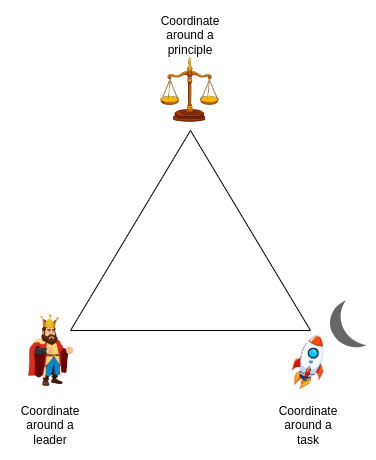
Coordinating around a task is powerful, but it is temporary, and any
social capital you build up easily dissipates once that particular task
is complete. Leaders and principles are powerful because they are
factories of tasks: they can keep outputting new things to do
and new answers for how to resolve new problems again and again. And of
those two options, principles are far more socially scalable and far
more durable.
Plurality seems to stand sharply in opposition to the broader trends.
Together with very few other modern movements (perhaps network states),
it goes far beyond any single task in scope, and it seeks to coordinate
around a principle, and not a leader. One way to understand
Plurality, is that it recognizes that (at least at very large scales)
coordinating around principles is the superior point on the triangle,
and it's trying to do the hard work of figuring out the new set of
principles that work well for the 21st century. Radical Markets
was trying to reinvent the fields of economics and mechanism design.
Plurality is trying to reinvent liberalism.
The way in which all of the mechanisms described in the sections
above combine into a single framework is best exemplified in this chart
by Gisele Chou:
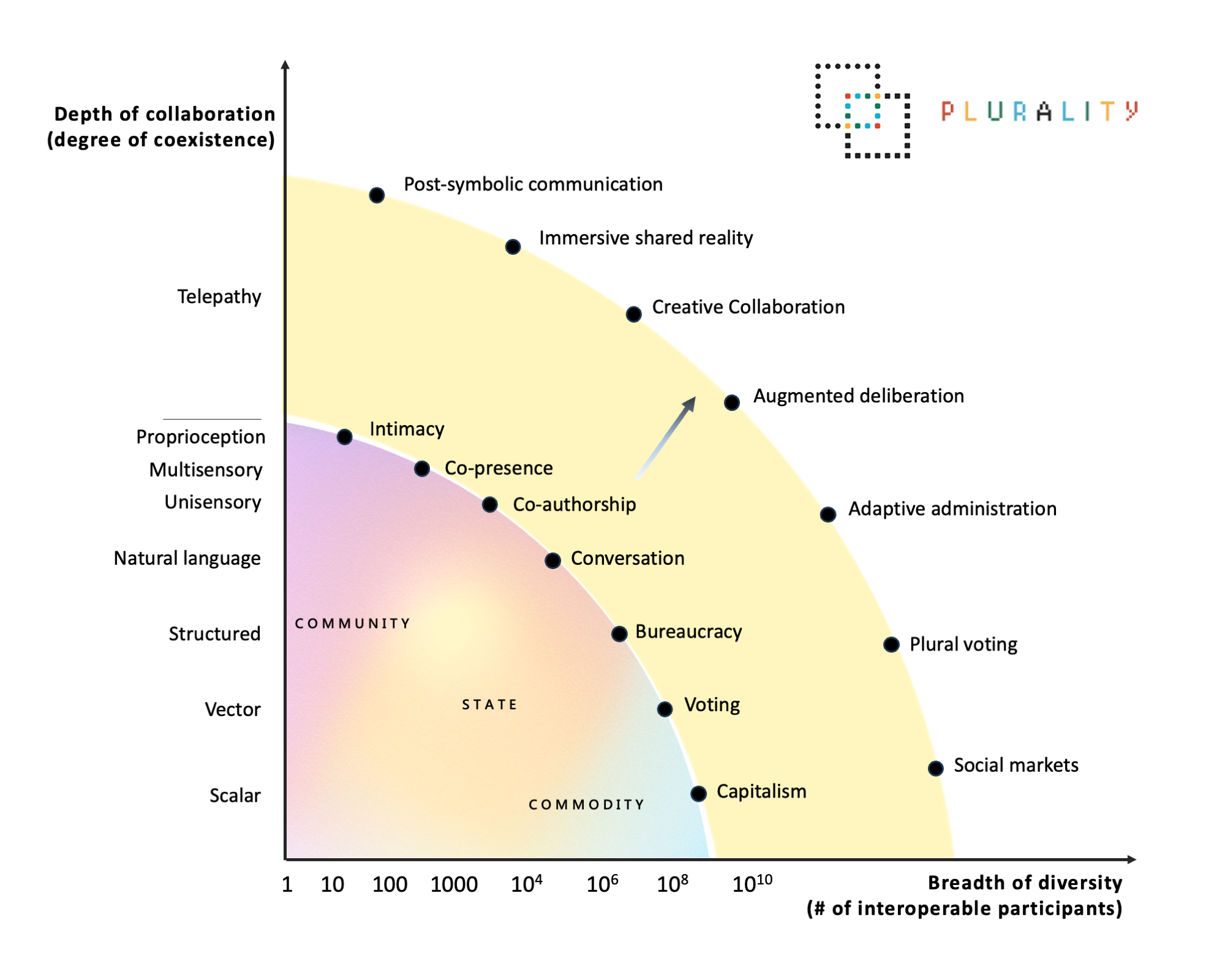
On one level, the framework makes total sense. The philosopher Nassim
Taleb loves
to quote Geoff and Vince Graham to describe his rejection of
"scale-free universalism": "I am, at the Fed level, libertarian; at the
state level, Republican; at the local level, Democrat; and at the family
and friends level, a socialist". Plurality philosophy takes this
seriously, recommending different mechanisms at different scales.
On another level, it sometimes feels like "the Plurality vibe" is
acting as an umbrella that is combining very different
concepts, that have very different reasons for accepting or
rejecting them. For example, "creating healthy connections between
people is very important" is a very different statement from "voting
mechanisms need to take differences in degree of connectedness into
account". It's entirely possible that pairwise quadratic funding can be
used to make a new and better United Nations that subsidizes cooperation
and world peace, but at the same time "creative collaborations" are
overrated and great works should be the vision of one author. Some of
this seeming inconsistency comes from the book's diverse collaborative
authorship: for example, the virtual reality and brain-to-brain
sections, and much of the work on correlation discounts, was written by
Puja Ohlhaver, and her focuses are not quite the same as Glen's or
Audrey's. But this is a property of all philosophies: 19th century
liberalism combined democracy and markets, but it was a composite work
of many people with different beliefs. Even today, there are many people
who like democracy and are suspicious of markets, or like markets and
are suspicious of democracy.
And so one question worth asking is: if your background
instincts on various questions differ from "the Plurality vibe" on some
dimensions, can you still benefit from Plurality ideas? I will
argue that the answer is yes.
Is
Plurality compatible with wanting a crazy exponential future?
One of the impressions that you might get from reading Plurality is
that, while Glen and Audrey's meta-level visions for conversations and
governance are fascinating, they don't really see a future where
anything too technologically radical happens. Here
is a list of specific object-level outcomes that they hope to
achieve:
- The workplace, where we believe it could raise economic
output by 10% and increase the growth rate by a percentage
point
- Health, where we believe it can extend human life by two
decades
- Media, where it can heal the divides opened by social media, provide
sustainable funding, expand participation and dramatically increase
press freedom
- Environment, where it is core to addressing most of the
serious environmental problems we face, perhaps even more so
than traditional "green" technologies
- Learning, where it can upend the linear structure of current
schooling to allow far more diverse and flexible, lifelong
learning paths.
These are very good outcomes, and they are ambitious goals for the
next ten years. But the goals that I want to see out of a
technologically advanced society are much greater and deeper than this.
Reading this section reminded me of the recent review
I made of the museums of the future in Dubai vs Tokyo:
But their proposed solutions are mostly tweaks that try to make the
world more gentle and friendly to people suffering from these
conditions: robots that can help guide people, writing on business cards
in Braille, and the like. These are really valuable things that can
improve the lives of many people. But they are not what I would expect
to see in a museum of the future in 2024: a solution that lets people
actually see and hear again, such as optic nerve regeneration and brain
computer interfaces.
Something about the Dubai approach to these questions speaks deeply
to my soul, in a way that the Tokyo approach does not. I do not
want a future that is 1.2x better than the present, where I can enjoy 84
years of comfort instead of 70 years of comfort. I want a future that is
10000x better than the present ... If I become infirm and weak
for a medical reason, it would certainly be an improvement to live in an
environment designed to still let me feel comfortable despite these
disadvantages. But what I really want is for technology to fix
me so that I can once again become strong.
Dubai is an interesting example because it also uses another
technology that speaks deeply to my soul: geoengineering. Today, the
usage, and risks, of geoengineering are on a fairly local scale: the
UAE engages in cloud seeding and some blamed Dubai's recent floods
on it, though the
expert consensus seems to disagree. Tomorrow, however, there may be
much bigger prizes. One example is solar
geoengineering: instead of re-organizing our entire economy and
society to keep CO2 levels reasonably low and the planet reasonably
cool, there is a chance that all it takes to achieve a 1-4⁰C temperature
reduction is sprinkling the right salts into the air. Today, these ideas
are highly speculative, and the science is far too early to commit to
them, or use them as an excuse not to do other things. Even more modest
proposals like artificial lakes cause
problems with parasites. But as this century progresses, our ability
to understand the consequences of doing things like this will improve.
Much like medicine went from being often
net-harmful in earlier periods to crucially lifesaving today, our
ability to heal the planet may well go through a similar transition. But
even after the scientific issues become much more
well-understood, another really big question looms: how the hell
do we govern such a thing?
Environmental geopolitics is already a big question today. There are
already disputes
over water rights from rivers. If transformative continent-scale or
world-scale geoengineering becomes viable, these issues will become much
more high-stakes. Today, it seems hard to imagine any solution other a
few powerful countries coming together to decide everything on
humanity's behalf. But Plurality ideas may well be the best shot
we have at coming up with something better. Ideas around common
property, where certain resources or features of the environment can
have shared ownership between multiple countries, or even non-country
entities tasked with protecting the interests of the natural environment
or of the future, seem compelling in principle. Historically, the
challenge has been that such ideas are hard to formalize. Plurality
offers a bunch of theoretical tools to do just that.
If we zoom back out beyond the geoengineering issue, and think about
the category of "crazy exponential technology" in general, it
might feel like there is a tension between pluralism and technology
leading to exponential growth in capabilities. If different
entities in society progress according to a linear, or slightly
superlinear, trajectory, then small differences at time T remain small
differences at time T+1, and so the system is stable. But if the
progress is super-exponential, then small differences turn into
larger and larger differences, even in proportional terms, and the
natural outcome is one entity overtaking everything else.
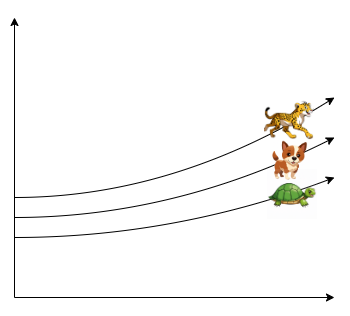
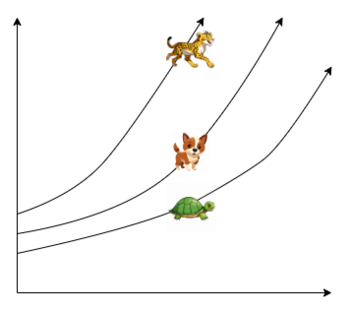
Left: slightly super-linear growth. Small differences at the
start become small differences at the end. Right: super-exponential
growth. Small differences at the start become very large differences
quickly.
Historically this has actually been a tradeoff. If you were to ask
which 1700s-era institutions feel the most "pluralist", you might have
said things like deeply-rooted extended family ties and trade guilds.
However, the Industrial Revolution sweeping these institutions away and
replacing them with economies of scale and industrial capitalism is
often precisely the thing that is credited
with enabling great economic growth.
However, I would argue that the static pluralism of the
pre-industrial age and Glen and Audrey's Plurality are fundamentally
different. Pre-industrial static pluralism was crushed by what
Glen calls "increasing returns". Plurality has tools specifically
designed for handling it: democratic mechanisms for funding public
goods, such as quadratic funding, and more limited versions of property
rights, where (especially) if you build something really powerful, you
only have partial ownership of what you build. With these techniques, we
can prevent super-exponential growth at the scale of human
civilization from turning into super-exponential growth in
disparities of resources and power. Instead, we design property
rights in such a way that a rising tide is forced to lift all boats.
Hence, I would argue that exponential growth in technological
capability and Plurality governance ideas are highly
complementary.
Is
Plurality compatible with valuing excellence and expertise?
There is a strand in political thought that can be summarized as
"elitist liberalism": valuing the benefits of free choice and democracy
but acknowledging that some people's inputs are much higher quality than
others, and wanting to put friction or limits on democracy to give
elites more room to maneuver. Some recent examples include:
- Richard Hanania's concept
of "Nietzschean liberalism" where he seeks to reconcile his
long-held belief that "some humans are in a very deep sense better than
other humans ... society disproportionately benefits from the scientific
and artistic genius of a select few", and his growing appreciation for
the benefits of liberal democracy in avoiding outcomes that are
really terrible and in not over-entrenching specific elites
that have bad ideas.
- Garrett Jones's 10%
Less Democracy, which advocates for more indirect
democracy through longer term durations, more appointed positions, and
similar mechanisms.
- Bryan Caplan's guarded
support for free speech as an institution that at least
gives a chance for counter-elites to form and develop ideas under
hostile conditions, even if an open "marketplace of ideas" is far from a
sufficient guarantee that good ideas will win broader public
opinion.
There are parallel arguments on the other side of the political
spectrum, though the language there tends to focus on "professional
expertise" rather than "excellence" or "intelligence". The types of
solutions that people who make these arguments advocate often involve
making compromises between democracy and either plutocracy or
technocracy (or something that risks being worse than both) as ways of
trying to select for excellence. But what if, instead of making this
kind of compromise, we try harder to solve the problem directly?
If we start from a goal that we want an open pluralistic
mechanism that allows different people and groups to express and execute
on their diverse ideas so that the best can win, we can ask the
question: how would we optimize institutions with that idea in
mind?
One possible answer is prediction
markets.
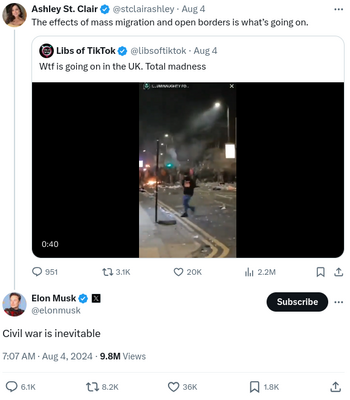
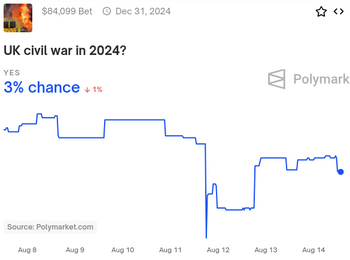
Left: Elon Musk proclaiming that civil war in the UK "is
inevitable". Right: Polymarket bettors, with actual skin in the game,
think that the probability of a civil war is.... 3% (and I think even
that's way too high, and I made a bet to that effect)
Prediction markets are an institution that allows different people to
express their opinions on what will happen in the future. The virtues of
prediction markets come from the idea that people are more likely to
give high-quality opinions when they have "skin in the game", and that
the quality of the system improves over time because people with
incorrect opinions will lose money, and people with correct opinions
will gain money.
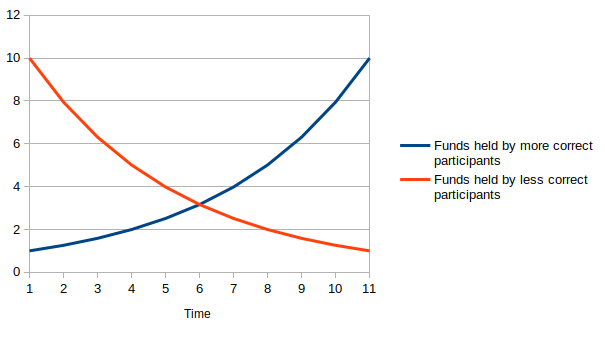
It is important to point out that while prediction markets
are pluralistic in the sense of being open to diverse participants, they
are not Pluralistic in Glen and Audrey's sense of the word.
This is because they are a purely financial mechanism: they do not
distinguish between $1 million bet by one person and $1 million bet by a
million unconnected people. One way to make prediction markets more
Pluralistic would be to introduce per-person subsidies, and
prevent people from outsourcing the bets that they make with these
subsidies. There are some mathematical arguments why this could do an
even better job than traditional prediction markets of eliciting
participants' knowledge and insights. Another option is to run a
prediction market and in parallel run a Polis-style discussion platform
that encourages people to submit their reasoning for why they believe
certain things - perhaps using soulbound
proofs of previous track record on the markets to determine whose voice
carries more weight.
Prediction markets are a tool that can be applied in many form
factors and contexts. One example is retroactive
public goods funding, where public goods are funded after
they have made an impact and enough time has passed that the impact can
be evaluated. RPGF is typically conceived of as being paired with an
investment ecosystem, where ahead-of-time funding for public
goods projects would be provided by venture capital funds and investors
making predictions about which projects will succeed in the future. Both
the after-the-fact piece (evaluation) and the before-the-fact piece
(prediction) can be made more Pluralistic: some form of quadratic voting
for the former, and per-person subsidies for the latter.
The Plurality book and related writings do not really feature a
notion of "better vs worse" ideas and perspectives, only of getting more
benefit from aggregating more diverse perspectives. On the
level of "vibes", I think there is an actual tension here. However, if
you believe that the "better vs worse" axis is important, then I do not
think that these focuses are inherently incompatible: there are ways to
take the ideas of one to improve mechanisms that are designed for the
other.
Where could these
ideas be applied first?
The most natural place to apply Plurality ideas is social settings
that are already facing the problem of how to improve collaboration
between diverse and interacting tribes while avoiding centralization and
protecting participants' autonomy. I personally am most bullish on
experimentation in three places: social media,
blockchain ecosystems and local
government. Particular examples include:
- Twitter's Community
Notes, whose note ranking system is already designed to
favor notes that gain support across a wide spectrum of participants.
One natural path toward improving Community Notes would be to find ways
to combine it with prediction markets, thereby encouraging sophisticated
actors to much more quickly flag posts that will get noted.
- User-facing anti-fraud software. Message Checker,
as well as the Brave browser and some
crypto wallets, are early examples of a paradigm of software that works
aggressively on the user's behalf to protect the user from threats
without needing centralized backdoors. I expect that Software like this
will be very important, but it carries the inherent political question
of determining what is and is not a threat. Plurality ideas can be of
help in navigating this issue.
- Public goods funding in blockchain ecosystems. The
Ethereum ecosystem makes heavy use
of quadratic funding and retroactive funding
already. Pluralistic mechanisms could help in bounding the vulnerability
of these mechanisms to collusion, and subsidize collaboration between
parts of the ecosystem that face pressures to act competitively towards
each other, eg. layer-2 scaling platforms and wallets.
- Network
states, popup
cities and related concepts. New voluntary communities that
form online based on shared interests, and then "materialize" offline,
have many needs for (i) having less dictatorial forms of governance
internally, (ii) cooperating more between each other, and (iii)
cooperating more with the physical jurisdictions in which they are
based. Plurality mechanisms could improve on all three.
- Publicly funded news media. Historically, media has
been funded either by listeners, or by the administrative arm of a
centralized state. Plurality mechanisms could enable more democratic
mechanisms, which also explicitly try to bridge across and reduce rather
than increase polarization.
- Local public goods: there are many hyper-local
governance and resource allocation decisions that could benefit from
Plurality mechanisms; my post on crypto
cities contains some examples. One possible place to start is
quasi-cities with highly sophisticated residents, such as
universities.
Today, I think that the right way to think about Plurality is as an
"intuition pump" for ideas for designing social mechanisms to better
preserve freedom of individuals and communities, enable large-scale
collaboration, and minimize polarization. The above contexts are good
grounds for experimentation because they contain (i) real-world problems
and resources, and (ii) people who are very interested in trying new
ideas.
Tomorrow, there are broader political questions about the structure
of the world in the 21st century, including what level of sovereignty
individuals, companies and nations have, how equal or unequal the world
ends up being, and which kinds of powerful technologies get developed in
what order and with what properties. Both "the Plurality vibe", and
specific implications of Plurality mechanism design theory, have a lot
to say on these topics.
Often, there are multiple contradictory ways to apply the ideas to
the same question. For example, Plurality philosophy implies that there
is value in elevating a group or mechanism if it's uncorrelated with
other dominant mechanisms in society and thus brings something unique to
the table. But are billionaires a welcome injection of uncorrelated
activity into a world dominated by nation-states that all operate by
very similar internal political logic, or are more active nation states
a welcome injection of diversity into a world dominated by homogeneous
billionaire capitalism? Your answer will likely depend on your
pre-existing feelings toward these two groups. For this reason, I think
Plurality is best understood not as an overarching substitute for your
existing frameworks of thinking about the world, but as a complement to
it, where the underlying ideas can make all kinds of mechanisms
better.
Plurality philosophy in an incredibly oversized nutshell
2024 Aug 21 See all postsSpecial thanks to Glen Weyl and Audrey Tang for discussion and Karl Floersch for review.
One of the interesting tensions in the crypto space, which has become a sort of digital home for my geographically nomadic self over the last decade, is its relationship to the topic of governance. The crypto space hails from the cypherpunk movement, which values independence from external constraints often imposed by ruthless and power-hungry politicians and corporations, and has for a long time built technologies like torrent networks and encrypted messaging to achieve these ends. With newer ideas like blockchains, cryptocurrencies and DAOs, however, there is an important shift: these newer constructions are long-lived, and constantly evolving, and so they have an inherent need to build their own governance, and not just circumvent the governance of unwanted outsiders. The ongoing survival of these structures depends crucially on mathematical research, open source software, and other large-scale public goods. This requires a shift in mentality: the ideology that maintains the crypto space needs to transcend the ideology that created it.
These kinds of complex interplays between coordination and freedom, especially in the context of newer technologies, are everywhere in our modern society, going far beyond blockchains and cryptocurrency. Earlier this year, Florida governor Ron DeSantis signed a bill that would ban synthetic (aka "lab-grown") meat from the state, arguing that "global elites want to control our behavior and push a diet of petri dish meat and bugs on Americans", and that we need to "prioritize our farmers and ranchers over ... the World Economic Forum". As you might expect, the Libertarian Party New Hampshire account publicly criticized the "authoritarian socialist" nature of the legislation. But as it turned out, many other self-described libertarians did not share the same opinion:
To me, LPNH's criticism of DeSantis's ban makes total sense: banning people from eating a new and potentially far more ethical and sustainable form of meat, on the basis of little more than a disgust reflex, is the exact opposite of valuing freedom. And yet, it's clear that many others do not feel the same way. When I scoured the internet for cogent arguments why, the most compelling I could find is this argument from Roko Mijic: in short, once something like this is allowed, it becomes mainstream, society reorganizes around it, and the lives of those who do not want to follow along inevitably become harder and harder. It happened with digital cash, to the point where even the Swedish central bank is worried about cash payments accessibility, so why wouldn't it happen in other sectors of technology as well?
About two weeks after the DeSantis signed the bill banning lab-grown meat, Google announced that it was rolling out a feature into Android that would analyze the contents of calls in real time, and would automatically give the user a warning if it thinks the user might be getting scammed. Financial scams are a large and growing problem, especially in regions like Southeast Asia, and they are becoming increasingly sophisticated more rapidly than many people can adapt. AI is accelerating this trend. Here, we see Google, creating a solution to help warn users about scams, and what's more, the solution is entirely client-side: there's no personal data being shipped off to any corporate or governmental Big Brother. This seems amazing; it's exactly the kind of tech that I advocated for in my post introducing "d/acc". However, not all freedom-minded people were happy, and at least one of the detractors was very difficult to dismiss as "just a Twitter troll": it was Meredith Whittaker, president of the Signal Foundation.
All three of these tensions are examples of things that have made a deep philosophical question repeatedly pop into my mind: what is the thing that people like myself, who think of ourselves as principled defenders of freedom, should actually be defending? What is the updated version of Scott Alexander's notion of liberalism as a peace treaty that makes sense in the twenty first century? Clearly, the facts have changed. Public goods are much more important than before, at larger scales than before. The internet has made communication abundant, rather than scarce. As Henry Farrell analyzed in his book on weaponized interdependence, modern information technology doesn't just empower the recipient: it also enables ongoing power projection by the creator. Existing attempts to deal with these questions are often haphazard, trying to treat them as exceptions that require principles to be tempered by pragmatic compromise. But what if there was a principled way of looking at the world, which values freedom and democracy, that can incorporate these challenges, and deal with them as a norm rather than an exception?
Table of contents
Plurality, the book
The above is not how Glen Weyl and Audrey Tang introduce their new book, Plurality: the future of collaborative technology and democracy. The narrative that animates Glen is a somewhat different one, focusing on the increasingly antagonistic relationship between many Silicon Valley tech industry figures and the political center-left, and seeking to find a more collaborative way forward:
Glen Weyl, introducing the Plurality book in a presentation in Taipei
But it felt more true to the spirit of the book for me to give an introduction that gestures at a related set of problems from my own angle. After all, it is an explicit goal of Plurality to try to be compelling to a pretty wide group of people with a wide set of concerns, that draw from all different parts of the traditional political spectrum. I've long been concerned about what has felt to me like a growing decline of support for not just democracy but even freedom, which seems to have accelerated since around 2016.
I've also had a front-row seat dealing with questions of governance from the governance builder's side, from my role within the Ethereum ecosystem. At the start of my Ethereum journey, I was originally animated by the dream of creating a governance mechanism that was provably mathematically optimal, much like we have provably optimal consensus algorithms. Five years later, my intellectual exploration ended up with me figuring out the theoretical arguments why such a thing is mathematically impossible.
Glen's intellectual evolution was in many ways different from mine, but in many ways similar. His previous book Radical Markets featured ideas inspired by classical liberal economics, as well as more recent mathematical discoveries in the field, to try to create better versions of property rights and democracy that solve the largest problems with both mechanisms. Just like me, he has always found ideas of freedom and ideas of democracy both compelling, and has tried to find the ideal combination of both, that treats them not as opposite goals to be balanced, but as opposite sides of the same coin that need to be integrated. More recently, just like what happened with me, the mathematical part of his social thinking has also moved in the direction of trying to treat not just individuals, but also connections between individuals, as a first-class object that any new social design needs to take into account and build around, rather than treating it as a bug that needs to be squashed.
It is in the spirit of these ideas, as well as in the spirit of an emerging transition from theory to practice, that the Plurality book is written.
How would I define Plurality in one sentence?
In his 2022 essay "Why I Am A Pluralist", Glen Weyl defines pluralism most succinctly as follows:
If I had to expand on that a little bit, and define Plurality the book in four bullet points, I would say the following:
The book also includes contributions from many authors other than Glen and Audrey, and if you reach the chapters closely you will notice the different emphases. However, you will also find many common threads.
What are the megapolitics of Plurality?
In Balaji Srinivasan's magnum opus The Network State, Balaji described his vision of the current world as being split between three poles: center-left Anglosphere elites exemplified by the New York Times (NYT), the Chinese Communist Party (CCP), and ultra-individualistic right-leaning people as exemplified by Bitcoin (BTC). Glen, both in the Plurality book and elsewhere, has given his own characterization of the "political ideologies of the 21st century", that looks as follows:
The names of the three are taken from Civilization 6, and in the Plurality book Glen simplifies the names to Technocracy, Libertarianism and Plurality. He describes the three roughly as follows:
Glen sees Plurality as being uniquely able to simultaneously avoid three failure modes: coordination failure leading to conflict (which he sees Libertarianism as risking), centralization and authoritarianism (which he sees Technocracy as risking), and stagnation (which he sees "old-world democracy" as risking, causing it to lose competitiveness against Libertarianism and Technocracy). Glen sees Plurality as an under-explored alternative which it is his project to flesh out as an idea, and Audrey's project to bring to life, first in Taiwan then elsewhere.
If I had to summarize the difference between Balaji's program and Glen and Audrey's program, I would do so as follows. Balaji's vision centers around creating new alternative institutions and new communities around those new institutions, and creating safe spaces to give them a chance to grow. Glen and Audrey's approach, on the other hand, is best exemplified by her "fork-and-merge" strategy in e-government in Taiwan:
There is still some choice and exit in Audrey's vision, but there is a much tighter feedback loop by which the improvements created by micro-exits get merged back into "mainline" societal infrastructure. Balaji would ask: how do we let the synthetic meat people have their synthetic meat city, and the traditional meat people have their traditional city? Glen and Audrey might rather ask: how do we structure the top levels of society to guarantee people's freedom to do either one, while still retaining the benefits of being part of the same society and cooperating on every other axis?
What is the Plurality model of "the world as it is"?
The Plurality view on how to improve the world starts with a view on how to describe the world as it is. This is a key part of Glen's evolution, as the Glen of ten years ago had a much more economics-inspired perspective toward these issues. For this reason, it's instructive to compare and contrast the Plurality worldview with that of traditional economics.
Traditional economics focuses heavily on a small number of economic models that make particular assumptions about how agents operate, and treats deviations from these models as bugs whose consequences are not too serious in practice. As given in textbooks, these assumptions include:
In my own recent writing, I generally put a stronger emphasis on an assumption that is related to competition, but is much stronger: independent choice. Lots of mechanisms proposed by economists work perfectly if you assume that people are acting independently to pursue their own independent objectives, but break down quickly once participants are coordinating their actions though some mechanism outside of the rules that you set up. Second price auctions are a great example: they are provably perfectly efficient if the above conditions are met and the participants are independent, but break heavily if the top bidders can collude. Quadratic funding, invented by myself, Glen Weyl and Zoe Hitzig, is similar: it's a provably ideal mechanism for funding public goods if participants are independent, but if even two participants collude, they can extract an unbounded amount of money from the mechanism. My own work in pairwise-bounded quadratic funding tries to plug this hole.
But the usefulness of economics breaks down further once you start to analyze incredibly important parts of society that don't look like like trading platforms. Take, for instance, conversations. What are the motivations of speakers and listeners in a conversation? As Hanson and Simler point out in The Elephant In The Brain, if we try to model conversations as information exchange, then we would expect to see people guarding information closely and trying to play tit-for-tat games, saying things only in exchange for other people saying things in return. In reality, however, people are generally eager to share information, and criticism of people's conversational behavior often focuses on many people's tendency to speak too much and listen too little. In public conversations such as social media, a major topic of analysis is what kinds of statements, claims or memes go viral - a term that directly admits that the most natural scientific field to draw analogies from is not economics, but biology.
So what is Glen and Audrey's alternative? A big part of it is simply recognizing that there is simply no single model or scientific approach that can explain the world perfectly, and we should use a combination of different models instead, recognizing the limits of the applicability of each one. In a key section, they write:
Glen and Audrey proceed to give similar examples from physics. An example that I (as one of many co-contributors in the wiki-like process of producing the book) contributed, and they accepted, was:
In biology, a key example is:
The theme of these examples should at this point be easy to see. There is no single model that can be globally applicable, and the best that we can do is stitch together many kinds of models that work well in many kinds of situations. The underlying mechanisms at different scales are not the same, but they do "rhyme". Social science, they argue, needs to go in the same direction. And this is exactly where, they argue, "Technocracy" and "Libertarianism" fail:
One particular model that Glen and Audrey come back to again and again is Georg Simmel's theory of individuality as arising from each individual being at a unique intersection of different groups. They describe this as being a long-lost third alternative to both "atomistic individualism" and collectivism. They write:
This is the core idea that the Plurality book comes back to again and again: treating connections between individuals as a first class object in mechanism design, rather than only looking at individuals themselves.
How does Plurality differ from libertarianism?
Robert Nozick, in his 1974 book Anarchy, State and Utopia, argued for a minimal government that performs basic functions like preventing people from initiating violent force, but otherwise leaves it up to people to self-organize into communities that fulfill their values. This book has become something of a manifesto describing an ideal world for many classical liberals since then.
Two examples that come to mind for me are Robin Hanson's recent post Libertarianism as Deep Multiculturalism, and Scott Alexander's 2014 post Archipelago and Atomic Communitarianism. Robin is interested in this concept because he wants to see a world that has more of what he calls deep multiculturalism:
Scott Alexander comes to similar conclusions in his 2014 post, though his underlying goal is slightly different: he wants to find an ideal political architecture that creates the opportunity for organizations to support public goods and limit public bads that are culturally subjective, while limiting the all-too-common tendency for subjective arguments about higher-order harm ("the gays are corroding the social fabric") to become a mask for oppression. Balaji's The Network State is a much more concrete proposal for a social architecture that tries to accomplish exactly the same objective.
And so a key question worth asking is: where exactly is libertarianism insufficient to bring about a Plural society? If I had to summarize the answer in two sentences, I would say:
To understand (2), we can zoom in on one particular example. Let us look at the debate around Google's on-device anti-fraud scanning system in the opening section. On one side, we have a tech company releasing a product that seems to be earnestly motivated by a desire to protect users from financial scams (which are a very real problem and have cost people I personally know hundreds of thousands of dollars), which even goes the extra mile and checks the most important "cypherpunk values" boxes: the data and computation stays entirely on-device and it's purely there to warn you, not report you to law enforcement. On the other side, we see Meredith Whittaker, who sees the offering as a slippery slope toward something that does do more oppressive things.
Now, let's look at Glen's preferred alternative: a Taiwanese app called Message Checker. Message checker is an app that runs on your phone, and intercepts incoming message notifications and does analysis with them. This includes features that have nothing to do with scams, such as using client-side algorithms to identify messages that are most important for you to look at. But it also detects scams:
A key part of the design is that the app does not force all of its users into one global set of rules. Instead, it gives users a choice of which filters they turn on or off:
From top to bottom: URL checking, cryptocurrency address checking, rumor checking.
These are all filters that are made by the same company. A more ideal setup would have this be part of the operating system, with an open marketplace of different filters that you can install, that would be created by a variety of different commercial and non-profit actors.
The key Pluralist feature of this design is: it gives users more granular freedom of exit, and avoids being all-or-nothing. If a norm that on-device anti-fraud scanning must work in this way can be established, then it seems like it would make Meredith's dystopia much less likely: if the operator decides to add a filter that treats information about transgender care (or, if your fears go the other direction, speech advocating limits on gender self-categorization in athletics competitions) as dangerous content, then individuals would be able to simply not install that particular filter, and they would still benefit from the rest of the anti-scam protection.
One important implication is that "meta-institutions" need to be designed to encourage other institutions to respect this ideal of granular freedom of exit - after all, as we've seen with software vendor lock-in, organizations don't obey this principle automatically!
One way to think about the complex interplay between coordination and autonomy in Plurality.
How does Plurality differ from democracy?
A lot of the differences between Plural democracy and traditional democracy become clear once you read the chapter on voting. Plural voting mechanisms have some strong explicit answers to the "democracy is two wolves and one sheep voting on what's for dinner" problem, and related worries about democracy descending into populism. These solutions build on Glen's earlier ideas around quadratic voting, but go a step further, by explicitly counting votes more highly if those votes come from actors that are more independent of each other. I will get into this more in a later section.
In addition to this big theoretical leap from only counting individuals to also counting connections, there are also broad thematic differences. One key difference is Plurality's relationship to nation states. A major disadvantage of nation-state democracy that speaks to me personally was summarized well in this tweet by libertarian philosopher Chris Freiman:
This is a serious gap: two thirds of global inequality is between countries rather than within countries, an increasing number of (especially digital) public goods are not global but also not clearly tied to any specific nation state, and the tools that we use for communication are highly international. A 21st century program for democracy should take these basic facts much more seriously.
Plurality is not inherently against the existence of nation states, but it makes an explicit effort to expand beyond relying on nation states as its locus of action. It has prescriptions for how all kinds of actors can act, including transnational organizations, social media platforms, other types of businesses, artists and more. It also explicitly acknowledges that for many people, there is no overarching single nation-state that dominates their lives.
Left: a concentric circle view of society, from a sociology paper in 2004. Right: a Plural view of society: intersecting, but non-hierarchical circles.
A big theme of Plurality is expanded on in much more detail in Ken Suzuki's Smooth Society and its Enemies: the idea that membership in an organization should not be treated as a "true-or-false" question. Instead, there should be different degrees of membership, and these different degrees would carry different benefits and different levels of obligation. This is an aspect of society that was always true, but becomes much more important in an internet-first world where our communities are no longer necessarily nested and fully overlapping.
What are some specific technologies that the Plurality vision advocates?
The Plurality book advocates for a pretty wide set of digital and social technologies that stretch across what are traditionally considered a large number of "spaces" or industries. I will give examples by focusing on a few specific categories.
Identity
First, Glen and Audrey's criticism of existing approaches to identity. Some key quotes from the chapter on this topic:
On biometrics:
Glen and Audrey's preferred approach is intersectional social identity: using the entire set of a person's actions and interactions to serve the underlying goals of identity systems, like determining the degree of membership in communities and degree of trustworthiness of a person:
The core message is any single-factor technique is too fragile, and so we should use multi-factor techniques. For account recovery, it is relatively easy to see how this works, and it's easy to understand the security model: each user chooses what they trust, and if a particular user makes a wrong choice, the consequences are largely confined to that user. Other use cases of identity, however, are more challenging. UBI and voting, for example, seem like they inherently require global (or at least community-wide) agreement on who the members of a community are. But there are efforts that try very hard to bridge this gap, and create something that comes close to "feeling" like a single global thing, while being based on subjective multi-factorial trust under the hood.
The best example in the Ethereum ecosystem would be Circles, a UBI coin project that is based on a "web of trust", where anyone can create an account (or an unlimited number of accounts) that generates 1 CRC per hour, but you only treat a given account's coins as being "real Circles" if that account is connected to you through a web-of-trust graph.
Propagation of trust in Circles, from the Circles whitepaper
Another approach would be to abandon the "you're either a person or you're not" abstraction entirely, and try to use a combination of factors to determine the degree of trustworthiness and membership of a given account, and give it a UBI or voting power proportional to that score. Many airdrops that are being done in the Ethereum ecosystem, such as the Starknet airdrop, follow these kinds of principles.
Starknet airdrop recipient categories. Many recipients ended up falling into multiple categories.
Plural Money and Property
In Radical Markets, Glen focused a lot on the virtues "stable and predictable, but deliberately imperfect" versions of property rights, like Harberger taxes. He also focused a lot on "market-like" structures that can fund public goods and not just private goods, most notably quadratic voting and quadratic funding. These are both ideas that continue to be prominent in Plurality. A non-monetary implementation of quadratic funding called Plural Credits was used to help record contributions to the book itself. The ideas around Harberger taxes are somewhat updated, seeking to extend the idea into mechanisms that allow assets to be partially owned by multiple different individuals or groups at the same time.
In addition to this ongoing emphasis on very-large-scale market designs, one new addition to the program is a greater emphasis on community currencies:
The underlying goal is to have a combination of local mechanisms that are deliberately kept local, and global mechanisms to enable very-large-scale cooperation. Glen and Audrey see their modified versions of markets and property as being the best candidates for very-large-scale global cooperation:
Voting
In Radical Markets, Glen advocated quadratic voting, which deals with the problem of allowing voters to express different strength of preferences but while avoiding failure modes where the most extreme or well-resourced voice dominates decision-making. In Plurality, the core problem that Glen and Audrey are trying to solve is different, and this section does a good job of summarizing what new problem they are trying to solve:
To fix this, Glen and Audrey argue for designing voting mechanisms with a principle of "degressive proportionality": treat uncorrelated signals additively, but give N correlated signals only sqrt(N) votes.
A precedent for this kind of approach exists in countries like the United States and in international bodies, where there are typically some chambers of governance that give sub-units (states in the former case, countries in the latter case) a quantity of voting power proportional to their population or economic power, and other chambers of governance that give one unit of voting power to each sub-unit regardless of size. The theory is that ten million voters from a big state matter more than a million voters from a small state, but they represent a more correlated signal than ten million voters from ten different states, and so the voting power that the ten million voters from a big state should be somewhere in between those two extremes.
Left: US senate, two senators per state regardless of size. Right: US electoral college, senator count roughly proportional to population.
The key challenge to making this kind of design work in a more general way is, of course, in determining who is "uncorrelated". Coordinated actors pretending to be uncoordinated to increase their legitimacy (aka "astroturfing", "decentralization larping", "puppet states"...) is already a mainstream political tactic and has been for centuries. If we instantiate a mechanism that determines who is correlated to whom by analyzing Twitter posts, people will start crafting their Twitter content to appear as uncorrelated as possible toward the algorithm, and perhaps even intentionally create and use bots to do this.
Here, I can plug my own proposed solution to this problem: vote simultaneously on multiple issues, and use the votes themselves as a signal of who is correlated to whom. One implementation of this was in pairwise quadratic funding, which allocates to each pair of participants a fixed budget, which is then split based on the intersection of how that pair votes. You can do a similar thing for voting: instead of giving one vote to each voter, you can give one (splittable) vote to each pair of voters:
If you count by raw numbers, YES wins 3-2 on issue C. But Alice, Bob and Charlie are highly correlated voters: they agree on almost everything. Meanwhile, David and Eve agree on nothing but C. In pairwise voting, the whole "NO on C" vote of the (David, Eve) pair would be allocated to C, and it would be enough to overpower the "YES on C" votes of Alice, Bob and Charlie, whose pairwise votes for C add up to only 11/12.
The key trick in this kind of design is that the determination of who is "correlated" and "uncorrelated" is intrinsic to the mechanism. The more that two participants agree on one issue, the less their vote counts on all other issues. A set of 100 "organic" diverse participants would get a pretty high weight on their votes, because the overlap area of any two participants is relatively small. Meanwhile, a set of 100 people who all have similar beliefs and listen to the same media would get a lower weight, because their overlap area is higher. And a set of 100 accounts that are all being controlled by the same owner would have perfect overlap, because that's the strategy that maximizes the owner's objectives, but they would get the lowest weight of all.
This "pairwise" approach is not the mathematically ideal way to implement this kind of thing: in the case of quadratic funding, the amount of money that an attacker can extract grows with the square of the number of accounts they control, whereas ideally it would be linear. There is an open research problem in specifying an "ideal" mechanism, whether for quadratic funding or voting, that has the strongest properties when faced with attackers controlling multiple accounts or correlated voters.
This is a new type of democracy that naturally corrects for the phenomenon that internet discourse sometimes labels as "NPCs": a large mass of people that might as well just be one person because they're all consuming exactly the same sources of information and believe all of the same things.
Conversations
As I've said on many occasions especially in the context of DAOs, the success or failure of governance depends ~20% on the formal governance mechanism, and ~80% on the structure of communication that the participants engage in before they get to the step where they've settled on their opinions and are inputting them into the governance. To that end, Glen and Audrey have also spent quite a lot of time thinking about better technologies for large-scale conversations.
One conversation tool that they focus on a lot is Polis. Polis is a system that allows people to submit statements about an issue, and vote on each other's statements. At the end of a round, it identifies the different major "clusters" in the different points of view, and surfaces the statements that were the most effective at getting support from all clusters.
Source: https://words.democracy.earth/hacking-ideology-pol-is-and-vtaiwan-570d36442ee5
Polis was actually used in Taiwan during some public deliberations over proposed laws, including agreeing on the rules for Uber-like ride hailing services. It has been used in several other contexts around the world as well, including some experiments within the Ethereum community.
The second tool that they focus on is one that has had much more success becoming mainstream, though in large part due to its "unfair advantage" from being introduced into a pre-existing social media platform with hundreds of millions of users: Twitter's Community Notes.
Community Notes similarly uses an algorithm that allows anyone to submit a proposed note for a post, and shows the notes that are rated the most highly by people who disagree on most other notes. I described this algorithm in much more detail in my review of the platform. Since then, Youtube has announced that they are planning to introduce a similar feature.
Glen and Audrey want to see the underlying ideas behind these mechanisms expanded on, and used much more broadly throughout the platforms:
The end goal is to try to create large-scale discussion platforms that are not designed to maximize metrics like "engagement", but are instead intentionally optimized around surfacing points of consensus between different groups. Live and let live, but also identify and take advantage of every possible opportunity to cooperate.
Brain-to-brain communication and virtual reality
Glen and Audrey spend two whole chapters on "post-symbolic communication" and "immersive shared reality". Here, the goal is to spread information from person to person in a way that is much higher bandwidth than what can be accomplished with markets or conversation.
Glen and Audrey describe an exhibit in Tokyo that gives the user a realistic sensory experience of what it's like to be old:
They argue that even more valuable and high-fidelity versions of these kinds of experiences can be made with future technologies like brain-computer interfaces. "Immersive shared reality", a cluster encompassing what we often call "virtual reality" or "the metaverse" but going broader than that, is described as a design space halfway in between post-symbolic communication and conversations.
Another recent book that I have read on similar topics is Herman Narula's Virtual Society: The Metaverse and the New Frontiers of Human Experience. Herman focuses heavily on the social value of virtual worlds, and the ways in which virtual worlds can support coordination within societies if they are imbued with the right social meaning. He also focuses on the risks of centralized control, arguing that an ideal metaverse would be created by something more like a non-profit DAO than a traditional corporation. Glen and Audrey have very similar concerns:
If I had to point to one difference in their visions, it is this. Virtual Society focuses much more heavily on the shared-storytelling and long-term continuity aspects of virtual worlds, pointing out how games like Minecraft win the hearts and minds of hundreds of millions despite being, by modern standards, very limited from a cinematic immersion perspective. Plurality, on the other hand, seems to focus somewhat more (though far from exclusively) on sensory immersion, and is more okay with short-duration experiences. The argument is that sensory immersion is uniquely powerful in its ability to convey certain kinds of information that we would otherwise have a hard time getting. Time will tell which of these visions, or what kind of combination of both, will prove successful.
Where does Plurality stand in the modern ideological landscape?
When I reflect on the political shifts that we've seen since the early 2010s, one thing that strikes me is that the movements that succeed in the current climate all seem to have one thing in common: they are all object-level rather than meta-level. That is, rather than seeking to promote broad overarching principles for how social or political questions should be decided, they seek to promote specific stances on specific issues. A few examples that come to mind include:
Of the modern movements that have not become issue-driven in this way, a large portion could be viewed as obfuscated personality cults, rallying around whatever set of positions is adopted and changed in real time by a single leader or small well-coordinated elite. And still others can be criticized for being ineffective and inconsistent, constantly trying to force an ever-changing list of causes under the umbrella of an ill-defined and unprincipled "Omnicause".
If I had to ask myself why these shifts are taking place, I would say something like this: large groups have to coordinate around something. And realistically, you either (i) coordinate around principles, (ii) coordinate around a task, or (iii) coordinate around a leader. When the pre-existing set of principles becomes perceived as being worn out and less effective, the other two alternatives naturally become more popular.
Coordinating around a task is powerful, but it is temporary, and any social capital you build up easily dissipates once that particular task is complete. Leaders and principles are powerful because they are factories of tasks: they can keep outputting new things to do and new answers for how to resolve new problems again and again. And of those two options, principles are far more socially scalable and far more durable.
Plurality seems to stand sharply in opposition to the broader trends. Together with very few other modern movements (perhaps network states), it goes far beyond any single task in scope, and it seeks to coordinate around a principle, and not a leader. One way to understand Plurality, is that it recognizes that (at least at very large scales) coordinating around principles is the superior point on the triangle, and it's trying to do the hard work of figuring out the new set of principles that work well for the 21st century. Radical Markets was trying to reinvent the fields of economics and mechanism design. Plurality is trying to reinvent liberalism.
The way in which all of the mechanisms described in the sections above combine into a single framework is best exemplified in this chart by Gisele Chou:
On one level, the framework makes total sense. The philosopher Nassim Taleb loves to quote Geoff and Vince Graham to describe his rejection of "scale-free universalism": "I am, at the Fed level, libertarian; at the state level, Republican; at the local level, Democrat; and at the family and friends level, a socialist". Plurality philosophy takes this seriously, recommending different mechanisms at different scales.
On another level, it sometimes feels like "the Plurality vibe" is acting as an umbrella that is combining very different concepts, that have very different reasons for accepting or rejecting them. For example, "creating healthy connections between people is very important" is a very different statement from "voting mechanisms need to take differences in degree of connectedness into account". It's entirely possible that pairwise quadratic funding can be used to make a new and better United Nations that subsidizes cooperation and world peace, but at the same time "creative collaborations" are overrated and great works should be the vision of one author. Some of this seeming inconsistency comes from the book's diverse collaborative authorship: for example, the virtual reality and brain-to-brain sections, and much of the work on correlation discounts, was written by Puja Ohlhaver, and her focuses are not quite the same as Glen's or Audrey's. But this is a property of all philosophies: 19th century liberalism combined democracy and markets, but it was a composite work of many people with different beliefs. Even today, there are many people who like democracy and are suspicious of markets, or like markets and are suspicious of democracy.
And so one question worth asking is: if your background instincts on various questions differ from "the Plurality vibe" on some dimensions, can you still benefit from Plurality ideas? I will argue that the answer is yes.
Is Plurality compatible with wanting a crazy exponential future?
One of the impressions that you might get from reading Plurality is that, while Glen and Audrey's meta-level visions for conversations and governance are fascinating, they don't really see a future where anything too technologically radical happens. Here is a list of specific object-level outcomes that they hope to achieve:
These are very good outcomes, and they are ambitious goals for the next ten years. But the goals that I want to see out of a technologically advanced society are much greater and deeper than this. Reading this section reminded me of the recent review I made of the museums of the future in Dubai vs Tokyo:
Dubai is an interesting example because it also uses another technology that speaks deeply to my soul: geoengineering. Today, the usage, and risks, of geoengineering are on a fairly local scale: the UAE engages in cloud seeding and some blamed Dubai's recent floods on it, though the expert consensus seems to disagree. Tomorrow, however, there may be much bigger prizes. One example is solar geoengineering: instead of re-organizing our entire economy and society to keep CO2 levels reasonably low and the planet reasonably cool, there is a chance that all it takes to achieve a 1-4⁰C temperature reduction is sprinkling the right salts into the air. Today, these ideas are highly speculative, and the science is far too early to commit to them, or use them as an excuse not to do other things. Even more modest proposals like artificial lakes cause problems with parasites. But as this century progresses, our ability to understand the consequences of doing things like this will improve. Much like medicine went from being often net-harmful in earlier periods to crucially lifesaving today, our ability to heal the planet may well go through a similar transition. But even after the scientific issues become much more well-understood, another really big question looms: how the hell do we govern such a thing?
Environmental geopolitics is already a big question today. There are already disputes over water rights from rivers. If transformative continent-scale or world-scale geoengineering becomes viable, these issues will become much more high-stakes. Today, it seems hard to imagine any solution other a few powerful countries coming together to decide everything on humanity's behalf. But Plurality ideas may well be the best shot we have at coming up with something better. Ideas around common property, where certain resources or features of the environment can have shared ownership between multiple countries, or even non-country entities tasked with protecting the interests of the natural environment or of the future, seem compelling in principle. Historically, the challenge has been that such ideas are hard to formalize. Plurality offers a bunch of theoretical tools to do just that.
If we zoom back out beyond the geoengineering issue, and think about the category of "crazy exponential technology" in general, it might feel like there is a tension between pluralism and technology leading to exponential growth in capabilities. If different entities in society progress according to a linear, or slightly superlinear, trajectory, then small differences at time T remain small differences at time T+1, and so the system is stable. But if the progress is super-exponential, then small differences turn into larger and larger differences, even in proportional terms, and the natural outcome is one entity overtaking everything else.
Left: slightly super-linear growth. Small differences at the start become small differences at the end. Right: super-exponential growth. Small differences at the start become very large differences quickly.
Historically this has actually been a tradeoff. If you were to ask which 1700s-era institutions feel the most "pluralist", you might have said things like deeply-rooted extended family ties and trade guilds. However, the Industrial Revolution sweeping these institutions away and replacing them with economies of scale and industrial capitalism is often precisely the thing that is credited with enabling great economic growth.
However, I would argue that the static pluralism of the pre-industrial age and Glen and Audrey's Plurality are fundamentally different. Pre-industrial static pluralism was crushed by what Glen calls "increasing returns". Plurality has tools specifically designed for handling it: democratic mechanisms for funding public goods, such as quadratic funding, and more limited versions of property rights, where (especially) if you build something really powerful, you only have partial ownership of what you build. With these techniques, we can prevent super-exponential growth at the scale of human civilization from turning into super-exponential growth in disparities of resources and power. Instead, we design property rights in such a way that a rising tide is forced to lift all boats. Hence, I would argue that exponential growth in technological capability and Plurality governance ideas are highly complementary.
Is Plurality compatible with valuing excellence and expertise?
There is a strand in political thought that can be summarized as "elitist liberalism": valuing the benefits of free choice and democracy but acknowledging that some people's inputs are much higher quality than others, and wanting to put friction or limits on democracy to give elites more room to maneuver. Some recent examples include:
There are parallel arguments on the other side of the political spectrum, though the language there tends to focus on "professional expertise" rather than "excellence" or "intelligence". The types of solutions that people who make these arguments advocate often involve making compromises between democracy and either plutocracy or technocracy (or something that risks being worse than both) as ways of trying to select for excellence. But what if, instead of making this kind of compromise, we try harder to solve the problem directly? If we start from a goal that we want an open pluralistic mechanism that allows different people and groups to express and execute on their diverse ideas so that the best can win, we can ask the question: how would we optimize institutions with that idea in mind?
One possible answer is prediction markets.
Left: Elon Musk proclaiming that civil war in the UK "is inevitable". Right: Polymarket bettors, with actual skin in the game, think that the probability of a civil war is.... 3% (and I think even that's way too high, and I made a bet to that effect)
Prediction markets are an institution that allows different people to express their opinions on what will happen in the future. The virtues of prediction markets come from the idea that people are more likely to give high-quality opinions when they have "skin in the game", and that the quality of the system improves over time because people with incorrect opinions will lose money, and people with correct opinions will gain money.
It is important to point out that while prediction markets are pluralistic in the sense of being open to diverse participants, they are not Pluralistic in Glen and Audrey's sense of the word. This is because they are a purely financial mechanism: they do not distinguish between $1 million bet by one person and $1 million bet by a million unconnected people. One way to make prediction markets more Pluralistic would be to introduce per-person subsidies, and prevent people from outsourcing the bets that they make with these subsidies. There are some mathematical arguments why this could do an even better job than traditional prediction markets of eliciting participants' knowledge and insights. Another option is to run a prediction market and in parallel run a Polis-style discussion platform that encourages people to submit their reasoning for why they believe certain things - perhaps using soulbound proofs of previous track record on the markets to determine whose voice carries more weight.
Prediction markets are a tool that can be applied in many form factors and contexts. One example is retroactive public goods funding, where public goods are funded after they have made an impact and enough time has passed that the impact can be evaluated. RPGF is typically conceived of as being paired with an investment ecosystem, where ahead-of-time funding for public goods projects would be provided by venture capital funds and investors making predictions about which projects will succeed in the future. Both the after-the-fact piece (evaluation) and the before-the-fact piece (prediction) can be made more Pluralistic: some form of quadratic voting for the former, and per-person subsidies for the latter.
The Plurality book and related writings do not really feature a notion of "better vs worse" ideas and perspectives, only of getting more benefit from aggregating more diverse perspectives. On the level of "vibes", I think there is an actual tension here. However, if you believe that the "better vs worse" axis is important, then I do not think that these focuses are inherently incompatible: there are ways to take the ideas of one to improve mechanisms that are designed for the other.
Where could these ideas be applied first?
The most natural place to apply Plurality ideas is social settings that are already facing the problem of how to improve collaboration between diverse and interacting tribes while avoiding centralization and protecting participants' autonomy. I personally am most bullish on experimentation in three places: social media, blockchain ecosystems and local government. Particular examples include:
Today, I think that the right way to think about Plurality is as an "intuition pump" for ideas for designing social mechanisms to better preserve freedom of individuals and communities, enable large-scale collaboration, and minimize polarization. The above contexts are good grounds for experimentation because they contain (i) real-world problems and resources, and (ii) people who are very interested in trying new ideas.
Tomorrow, there are broader political questions about the structure of the world in the 21st century, including what level of sovereignty individuals, companies and nations have, how equal or unequal the world ends up being, and which kinds of powerful technologies get developed in what order and with what properties. Both "the Plurality vibe", and specific implications of Plurality mechanism design theory, have a lot to say on these topics.
Often, there are multiple contradictory ways to apply the ideas to the same question. For example, Plurality philosophy implies that there is value in elevating a group or mechanism if it's uncorrelated with other dominant mechanisms in society and thus brings something unique to the table. But are billionaires a welcome injection of uncorrelated activity into a world dominated by nation-states that all operate by very similar internal political logic, or are more active nation states a welcome injection of diversity into a world dominated by homogeneous billionaire capitalism? Your answer will likely depend on your pre-existing feelings toward these two groups. For this reason, I think Plurality is best understood not as an overarching substitute for your existing frameworks of thinking about the world, but as a complement to it, where the underlying ideas can make all kinds of mechanisms better.